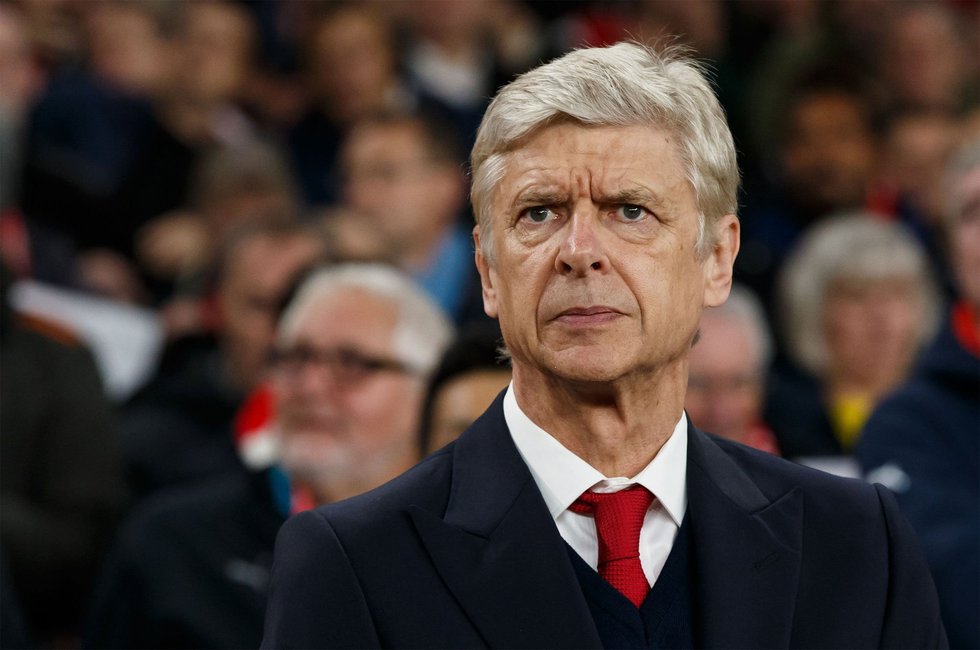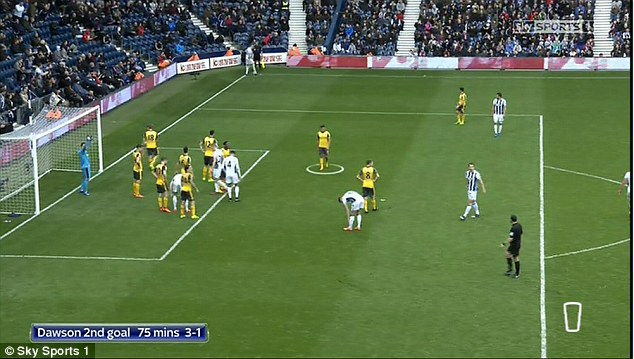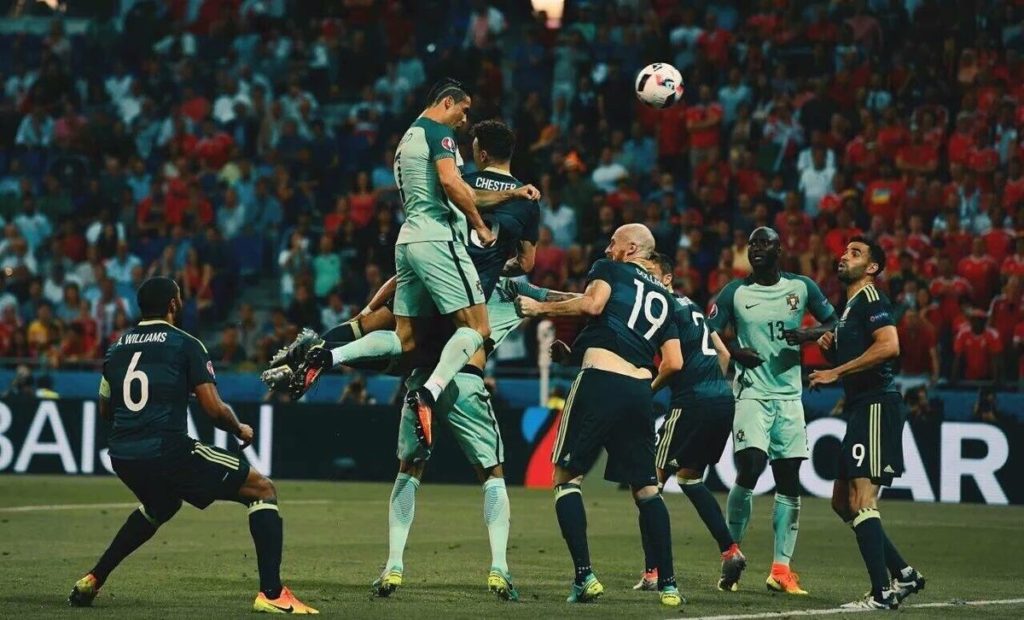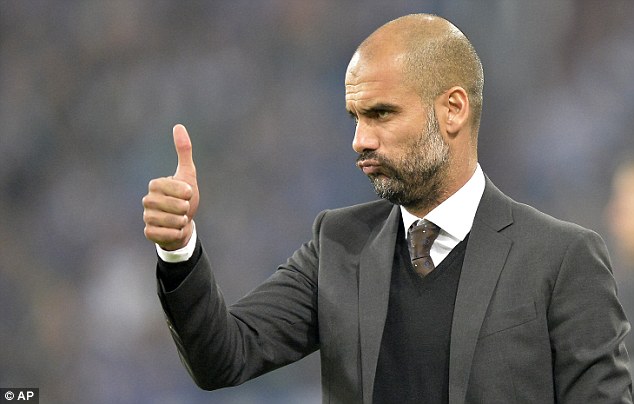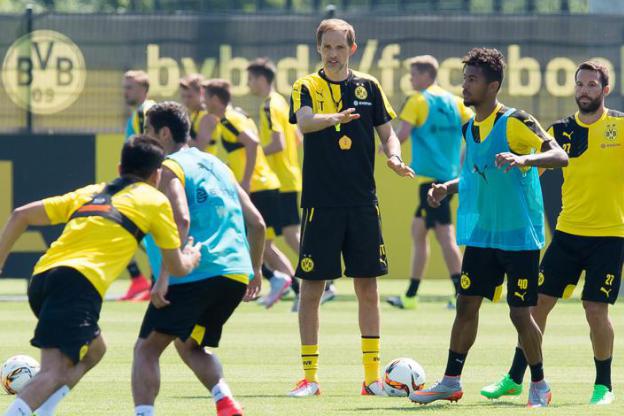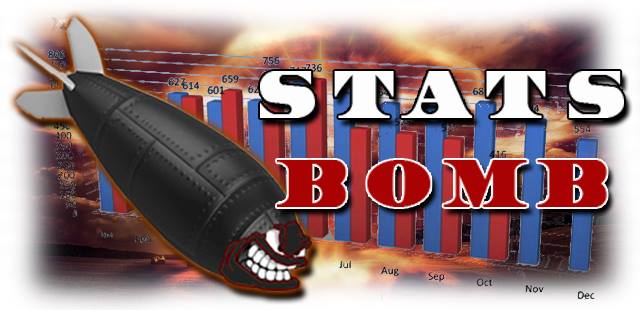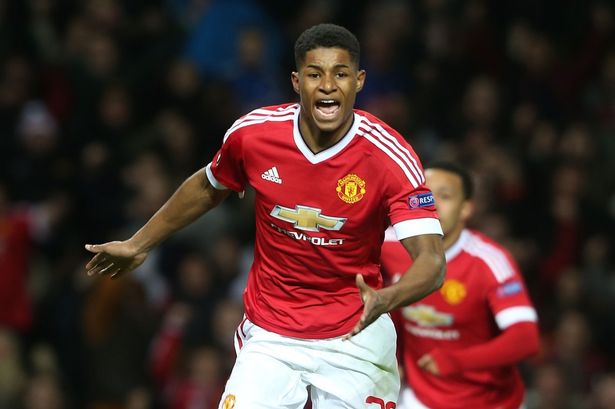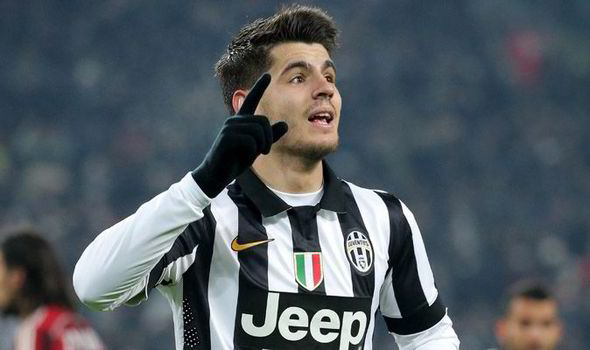In statistics, you rarely care about the outliers. If the data set is big enough, these are naturally occurring, but generally we want information about trending in the population as a whole. Outliers are something to be discarded. In sports, outliers are everything. In summer 2015, I was lucky enough to head up recruitment for Brentford football club in West London. We had to rebuild everything that McParland and Warburton took with them, and we had to do it from scratch, which meant scouting, market knowledge, player fit, etc. It was a monumental task, but we ended up with a really good recruitment team of Ricardo Larrandart, Nikos Overheul, Mark Andrews, and Robert Rowan, and a couple of part-time scouts including tactical superstar Rene Maric. From the point we knew Warbs was leaving until the close of the summer transfer window was one of the craziest and most exciting times of my life. We were both researching and applying statistical football theory to the transfer market on the fly. How well would players from various leagues translate to the English Championship? What was the lowest price we could pay for players and still get them? Could we rebuild an ageing squad into something that could potentially challenge for a promotion place again while playing an attractive, positive style? This is one of the stories from that summer... We knew we definitely weren’t getting Alex Pritchard back on loan. After finishing in the Championship Team of the Season in 14-15, Spurs wanted to keep him in training camp and then likely loan him out another rung up the ladder. There was the briefest chance we could get Dele Alli, but that quickly dissipated as he wowed Poch in training. This left a big hole for us in the 8/10 position. Our first choice was to get Arsenal’s Jon Toral back on loan. Toral was tremendous in limited minutes for Brentford in the playoff season, and his profile was unlike anyone else we could get in our price range. I sat next to him and talked him through what I saw from the numbers and what his age corollaries were in the data set. He seemed smart and interested. Unfortunately, somehow [former head coach] Marinus dragged his feet on whether Toral was the right fit. He was slow to make up his mind or get in touch with the player. Jon apparently was guaranteed starter minutes at Birmingham, and POOF! What seemed like a great fit flew right out the window, leaving us without a first-choice AMC. Owner Matthew Benham had negotiated to bring in Andy Gogia from Bundesliga 3’s Hallescher on a free in the spring. He could fill the role, but a bit like Alan Judge, we thought he would be better as a creative passer and dribbler out wide. (We also had Judge as a potential 8 because his defensive numbers were so good, but that never quite worked out.) We could not get Pascal Gross or Ziyech, and no one else was super exciting. Faced with a ticking clock and a very low budget that we would prefer to spend elsewhere, I put this Austrian guy no one had ever heard of back into the scouting queue. The data suggested he was a solid attacking midfielder who could dribble and had the great ability to create shots for teammates. He also had reasonable tackling stats for a guy who primarily attacked, and scouting agreed that he was decent at pressing. Now this was clearly a risk. At no time did we ever think, “Yes, this guy will be great in the Championship.” Instead we thought, “For the right price and in the right role, he certainly shows enough potential to be a solid performer in England.” Everything in transfers comes down to money. Are you paying the right price for the talent and the risk involved? In Brentford's budget, half a million pounds is a big deal, and a difference of £500K in valuation will kill a deal. In a Premier League budget, half a million pounds is chump change, and you'd be an idiot for missing out on a player for that small an amount. 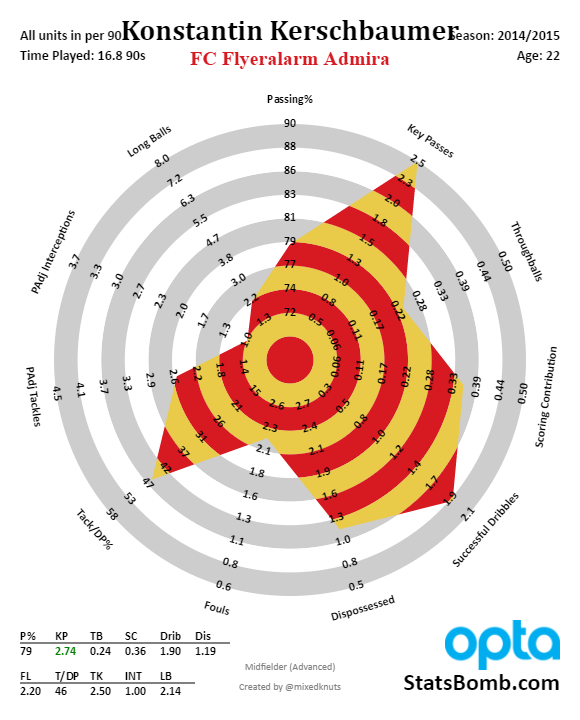 The numbers lined up and scouting was positive, so we needed to get in touch with his club and his agent to find out if we could afford him. That’s where the Chris Palmer story came from. [Scroll to the bottom here.] An eventual deal was sealed for low six-figures, and we had ourselves a low-cost wildcard of a 10 with potential upside. Even if Kersch was a bust, he was still probably cheaper than anyone we could have signed from League One, and for a club like Brentford, that mattered. The Real World Kerschbaumer showed up at training camp in amazing shape, and tested for the highest vO2 max in the group. Dude could run for days. It was all very exciting back then. Unfortunately, things in football go weird sometimes. Brentford went through three head coaches that season and by the end of it no one really knew he was supposed to play 10 except the recruitment guys. He basically never played at AMC until the dead end of the season in 15-16. Brentford had a horrible winter run, and things looked very grim. The club announced the closing of the academy and also the Football Analytics Team – my group – was made redundant as part of cost-cutting efforts. We had already finished most of the recruitment workload for the 16-17 season, and the perception was that the squad we had recruited was struggling mightily. Now the truth was that we intentionally built a youngish squad with the blessing of the owner because that is what we could afford, and also so that they could potentially grow and improve together. As long as your recruitment is good, this is a good plan. Then a funny thing happened. Brentford had an amazing run-in. From April 2nd at Nottingham Forest until the close of the season, they only lost one match, against eventual promoted side Hull. They also won six and drew two, most of which was without player of the season Alan Judge, who broke his leg in a nasty tackle at Ipswich. Scott Hogan finally came back from two different ACL injuries to be the hottest scorer in the league. Yoann Barbet started regularly with Harlee Dean in central defense, displaying an impressive passing range from his left boot, and a team that could not win a match from Christmas through February suddenly could not lose. Brentford finished 9th. Without the poor start from the Dijkhuizen era, they might have been right back in the playoff mix. Additionally, they did it with a massive surplus of transfer fees. Worst case scenario, performance suffered a little but the club was now making big money in the transfer market. Lost in this was Kerschbaumer’s performance. He subbed on when Judge broke his leg at Ipswich and set up Sam Saunders for the first Brentford goal. He also created an early goal for Hogan against Fulham, and two more in the final match of the season at Huddersfield. Then the summer came and seemingly Brentford once again forgot about Kerschbaumer. This wasn’t unfair – Brentford had a lot of competition for the midfielder roles, and Romaine Sawyers, Ryan Woods, Nico Yennaris, and Josh McEachran shared the bulk of the minutes. Injuries bit throughout the season though, and Kerschbaumer finally started to see more playing time, once again in the spring. Since March 18th, Brentford have lost once, drawn twice, and won five times. And once again, KK is out there racking up assists. Why the long story about a bit player in a small Championship team?
The numbers lined up and scouting was positive, so we needed to get in touch with his club and his agent to find out if we could afford him. That’s where the Chris Palmer story came from. [Scroll to the bottom here.] An eventual deal was sealed for low six-figures, and we had ourselves a low-cost wildcard of a 10 with potential upside. Even if Kersch was a bust, he was still probably cheaper than anyone we could have signed from League One, and for a club like Brentford, that mattered. The Real World Kerschbaumer showed up at training camp in amazing shape, and tested for the highest vO2 max in the group. Dude could run for days. It was all very exciting back then. Unfortunately, things in football go weird sometimes. Brentford went through three head coaches that season and by the end of it no one really knew he was supposed to play 10 except the recruitment guys. He basically never played at AMC until the dead end of the season in 15-16. Brentford had a horrible winter run, and things looked very grim. The club announced the closing of the academy and also the Football Analytics Team – my group – was made redundant as part of cost-cutting efforts. We had already finished most of the recruitment workload for the 16-17 season, and the perception was that the squad we had recruited was struggling mightily. Now the truth was that we intentionally built a youngish squad with the blessing of the owner because that is what we could afford, and also so that they could potentially grow and improve together. As long as your recruitment is good, this is a good plan. Then a funny thing happened. Brentford had an amazing run-in. From April 2nd at Nottingham Forest until the close of the season, they only lost one match, against eventual promoted side Hull. They also won six and drew two, most of which was without player of the season Alan Judge, who broke his leg in a nasty tackle at Ipswich. Scott Hogan finally came back from two different ACL injuries to be the hottest scorer in the league. Yoann Barbet started regularly with Harlee Dean in central defense, displaying an impressive passing range from his left boot, and a team that could not win a match from Christmas through February suddenly could not lose. Brentford finished 9th. Without the poor start from the Dijkhuizen era, they might have been right back in the playoff mix. Additionally, they did it with a massive surplus of transfer fees. Worst case scenario, performance suffered a little but the club was now making big money in the transfer market. Lost in this was Kerschbaumer’s performance. He subbed on when Judge broke his leg at Ipswich and set up Sam Saunders for the first Brentford goal. He also created an early goal for Hogan against Fulham, and two more in the final match of the season at Huddersfield. Then the summer came and seemingly Brentford once again forgot about Kerschbaumer. This wasn’t unfair – Brentford had a lot of competition for the midfielder roles, and Romaine Sawyers, Ryan Woods, Nico Yennaris, and Josh McEachran shared the bulk of the minutes. Injuries bit throughout the season though, and Kerschbaumer finally started to see more playing time, once again in the spring. Since March 18th, Brentford have lost once, drawn twice, and won five times. And once again, KK is out there racking up assists. Why the long story about a bit player in a small Championship team? 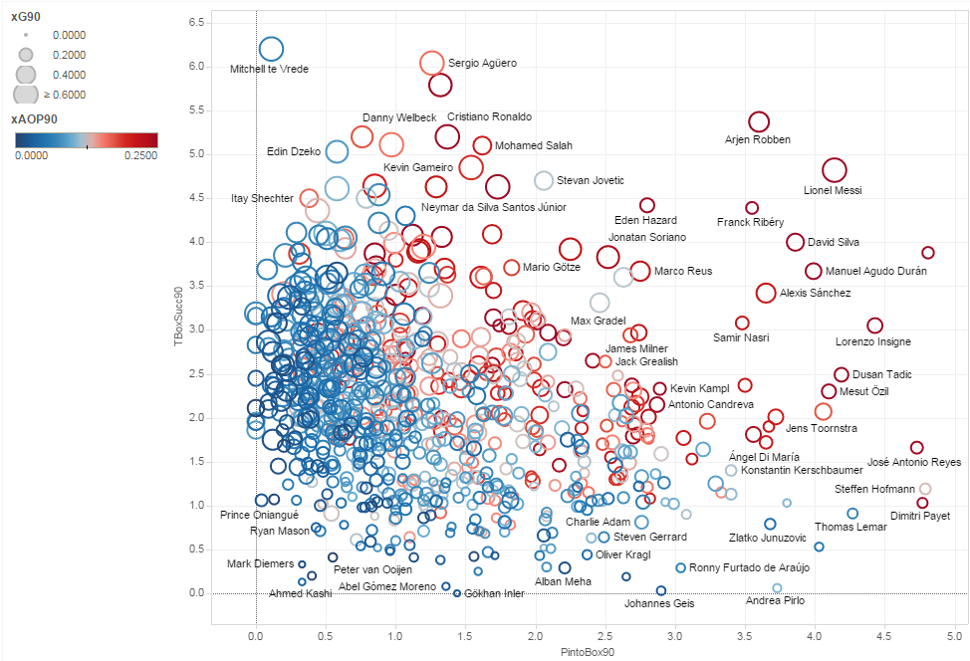 The answer is because Konstantin Kerschbaumer is a major outlier. Combine his minutes across two seasons and you get the following: 2320 minutes, 1 goal, 12 assists. That’s an assist rate of about .47 per 90, which is in the top 3% of footballers. Kersch also doesn’t take set pieces, meaning nearly all of his assists come from open play. To give you an idea of how unusual this is, in the last four seasons in the Championship nine players have posted 12 assists or more, all with more minutes and nearly all of them taking set pieces. Assists are really valuable – I view them basically the same as goals. Fans still have a very different perspective if a player scores half a goal a game than if he creates half an assist a game, there's a decent case to say they shouldn't. The bulk of Kerschbaumer’s minutes also came during that first year, many of which were not in his natural position. That's a tough situation to succeed in, but his numbers in this one particularly valuable area continue to be crazy. Is Kerschbaumer a success? I have no idea. It would be hard for Brentford to lose money on his transfer should he leave the club, so if that's how you grade success, I guess it's a check mark. He's also produced exactly what I thought he could when we recruited him. But... there are questions about whether he does enough on the pitch when he plays, and I can certainly see why those exist. I think he's still learning, and I hope he ends up with starter minutes next season, preferably in a system that plays him in his natural AMC spot. Like most data scientists, I want more data and preferably a lot of it. Part of me roots for the players we recruited like they are my children. I want them to succeed no matter what. There's also a part of me that is scientifically evaluating their successes and failures to see what worked, and what I need to do better the next time I have a chance to dabble in the transfer market. Anyway, the combination of Kersch's crazy assist rate in the run-in and Fabregas's continued creative skills for Chelsea made me think back to four years ago, when I first started writing about player stats. So much has changed in my approach, but remarkably, so much is still similar. I think a lot of the early ideas I latched on to as mattering ended up being very valuable. That said, I have made plenty of mistakes along the way, both inside and outside of football. Making mistakes - and learning from them - is most of the fun. Ted Knutson @mixedknuts ted@statsbombservices.com *Thanks again to Matthew Benham for the chance to do all of this while learning on the fly. Looking at the quality in the squad right now, I think we did pretty well.
The answer is because Konstantin Kerschbaumer is a major outlier. Combine his minutes across two seasons and you get the following: 2320 minutes, 1 goal, 12 assists. That’s an assist rate of about .47 per 90, which is in the top 3% of footballers. Kersch also doesn’t take set pieces, meaning nearly all of his assists come from open play. To give you an idea of how unusual this is, in the last four seasons in the Championship nine players have posted 12 assists or more, all with more minutes and nearly all of them taking set pieces. Assists are really valuable – I view them basically the same as goals. Fans still have a very different perspective if a player scores half a goal a game than if he creates half an assist a game, there's a decent case to say they shouldn't. The bulk of Kerschbaumer’s minutes also came during that first year, many of which were not in his natural position. That's a tough situation to succeed in, but his numbers in this one particularly valuable area continue to be crazy. Is Kerschbaumer a success? I have no idea. It would be hard for Brentford to lose money on his transfer should he leave the club, so if that's how you grade success, I guess it's a check mark. He's also produced exactly what I thought he could when we recruited him. But... there are questions about whether he does enough on the pitch when he plays, and I can certainly see why those exist. I think he's still learning, and I hope he ends up with starter minutes next season, preferably in a system that plays him in his natural AMC spot. Like most data scientists, I want more data and preferably a lot of it. Part of me roots for the players we recruited like they are my children. I want them to succeed no matter what. There's also a part of me that is scientifically evaluating their successes and failures to see what worked, and what I need to do better the next time I have a chance to dabble in the transfer market. Anyway, the combination of Kersch's crazy assist rate in the run-in and Fabregas's continued creative skills for Chelsea made me think back to four years ago, when I first started writing about player stats. So much has changed in my approach, but remarkably, so much is still similar. I think a lot of the early ideas I latched on to as mattering ended up being very valuable. That said, I have made plenty of mistakes along the way, both inside and outside of football. Making mistakes - and learning from them - is most of the fun. Ted Knutson @mixedknuts ted@statsbombservices.com *Thanks again to Matthew Benham for the chance to do all of this while learning on the fly. Looking at the quality in the squad right now, I think we did pretty well.
Author: Ted Knutson
It's NOT the Same Old Arsenal
Around football right now, we seem to be hearing that Arsenal are basically the same as every other year, but all the clubs around them have improved. Our numbers suggest that's not the case, and Arsenal's performance on both sides of the ball has fallen off this season.
Let's start with the obvious ones, the expected goals numbers.
Attacking xG 15-16: 1.97
Attacking xG 16-17: 1.67
Defensive xG 15-16: .95
Defensive xG 16-17: 1.09
So the attack is generating .30 xG fewer per game, while the defense is allowing .14 xG more. Combine the two and you get -.44 in expected goal difference, which is a huge whack when it comes to performance in the league table.
Where's that coming from? Well shot generation is down a touch on the attacking side, 14.6 to 15, but open play shot quality has fallen from .135 to .115 per shot, so the drop in attacking output is almost all down to the quality of shots Arsenal are generating this season.
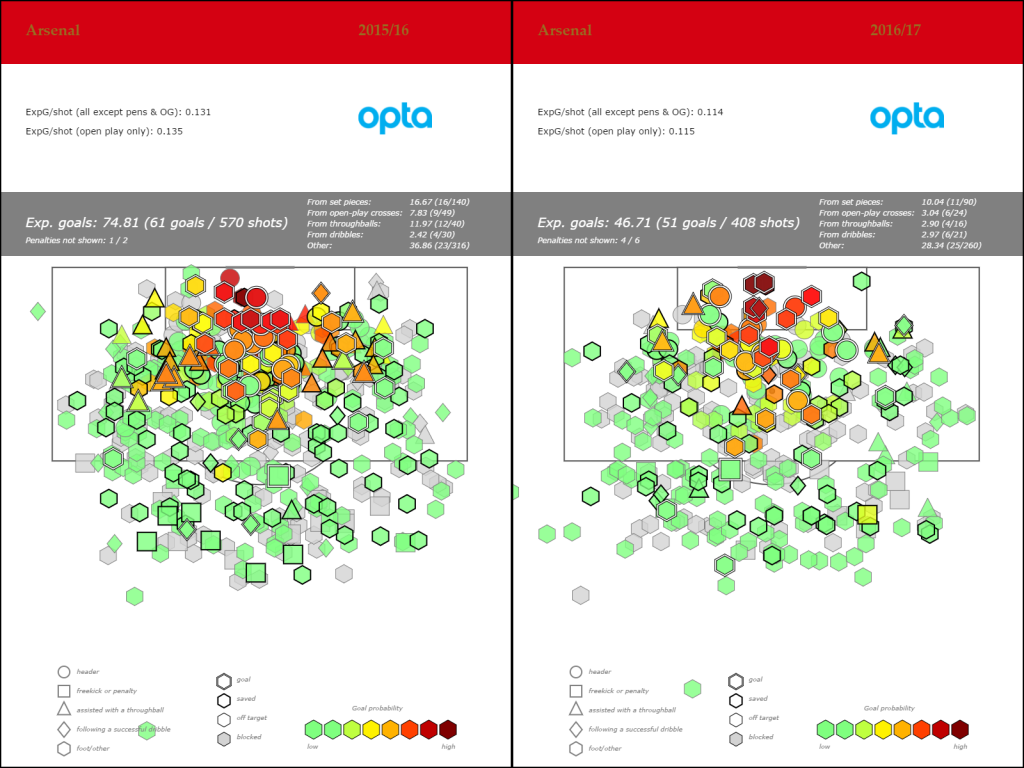
On the defensive side of the ball, Arsenal are actually giving up FEWER shots per game - 10.64 this season vs 11.82 last year. Again, the reason for the swing in xG Conceded is down to shot quality. In 15-16, Arsenal's average open play shot against was worth .075 xG. This season? .105.
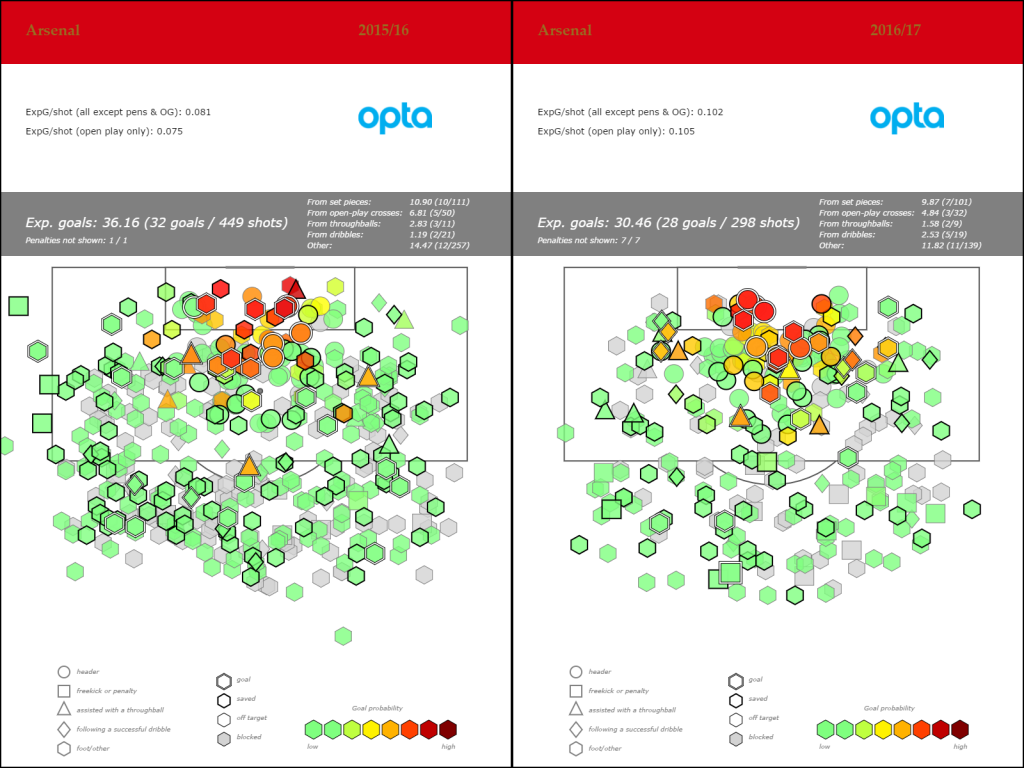
Arsenal's opponents are generating forty percent better shots than they were last season! What happened to all the long range pot shots?
In previous seasons Arsenal have gamed xG by generating 40-50% more shots than their opponents while having a huge quality differential between the shots they take and the ones they concede. This year the quality difference is almost completely gone, which has dramatically affected their expected goals numbers at both ends of the pitch. This feels like a strategic change on the part of their opponents, but maybe I'm reading too much into it.
How Do You Fix It?
This is a massive question and one that I don't really know the answer to. Are Arsenal defending badly? Have teams solved their defense, and because of that know how to create better chances against them?
Arsenal's attack is probably the best from a personnel perspective that it has been in ages, and yet that isn't exactly firing on all cylinders. Would Cazorla's presence magically heal all wounds? He only played 15 90's last year and the Gunners were much better then, so I'm not sure his absence again this year has enough explanatory power.
Average shot quality in attack is still better than the 14-15 season, but this has always been Wenger's special sauce that he brings to teams. This year it's still good, but it's no longer among the elite, and it needs to be for them to have a shot at winning the league. This year, it's just barely good enough to give them a shot at finishing 4th. This is also true because despite generating plenty of set piece chances, Arsenal are dead average in number of goals scored from them at 9.
Most worrying has to be the change in the defensive numbers. Arsenal tend to play a more passive style of defense than most of the top teams, trading shot suppression for forcing the opposition to take worse shots. However, this year they are giving up far higher xG shots, but doing it at nearly the same rate as before and basically at league average numbers. That's not gaming xG, that's just losing more games.
The question of why this is happening has lots of moving parts that seem to add up to a big problem. Monreal is finally showing a bit of age, and is no longer the elite defender he once was. though talented, Mustafi has had some issues bedding into the Premier League. Gabriel perhaps isn't as good as Arsenal thought when they bought him, and he's been forced to play right back when Bellerin is out.
Meanwhile in midfield, the aforementioned Cazorla may never be fully fit again. It's like Defensive Midfielder Groundhog Day Part 2, except instead of starring Mikel Arteta and his hair, we now have a different diminutive Spaniard playing the lead. Welsh hero Aaron Ramsey has played about the same amount as Santi, leaving Wenger to choose the so-called Dumb and Dumber axis of Coquelin-Xhaka as a double pivot, while occasionally adding El Neny, Oxlade-Chamberlain, or Alex Iwobi into the mix.
Last year's Arsenal looked like the best team in the league in the numbers, and a club that was close to taking the next steps in regularly competing for league titles instead of fourth place. This year's Arsenal looks almost exactly like their league position - likely to miss out on the Champions League for the first time in ages.
At least we know who to complain about all of this to. Unlike almost every other club in the Premier League, Arsene Wenger has full control at Arsenal. The question is whether he understands what the causes of the problems are, and whether he's adaptable enough at age 67 to rebuild this team for future title runs.
Despite a generation of good years together, Arsenal fans no longer seem convinced he's capable of anything other than 4th place trophies and Champions League knockout rounds, but they've certainly started yearning for something different.
Men on Posts and Starting Fires
I mentioned on Twitter recently that while I try to avoid disagreements when I am in a room with traditional football people, the one thing that is most likely to set off an argument is the topic of men on posts. Today I want to explain why that is the case, while covering a variety of other topics along the way.
Men on Posts
I swear to you, this topic comes up almost every week on highlight programs and game commentary. It is perhaps a bit less prevalent than discussion about the failings of zonal marking here in England, but it's an old favourite for the back-in-my-day commentator crowd. In 99.99% of the cases, it is also nothing but dead air and might as well be replaced with any other cliche that also gets spouted by the same commentator crowd. (We need better, smarter commentators, but that was a topic for a different day.)
My perspective on men on posts is that I almost never use them for defensive set pieces. There are a lot of reasons for this, but the basic principle is that I prefer active defending to passive and this takes one or two players completely out of the play where their only job is to act as last resorts. Now this isn't to say that I would never put men on posts. There are specific teams and situations where they are beneficial, but those are fairly unusual.
However, my preference for set piece defense isn't usually what starts the argument. Once the subject is broached, the conversation usually goes like this.
Me: "How do you feel about men on posts when defending set pieces?"
Traditionalist: "Oh, I would always have a man on [near¦far] post and sometimes a man on the other one."
Me: "Why?"
Trad: "Because [reasons]."
Me: "Okay, but how do you know?"
And this is where things invariably get awkward because usually they "know" because someone taught them this was the correct way to do things. Or possibly some anecdotally negative experience like, "we didn't have men on posts in this game, and the opposition scored a goal in the corner," changed previous behavior and now they protect against that scenario.
The problem here for someone like me is that when analysing most topics in football, I start back over at base principles. How do I know something? Well, I studied it. I typically take a large amount of qualitative and/or quantitative data, break it down, and then look at the outcomes to see what's there. Then I ask follow-up questions and pick at the results some more until I am comfortable I understand what I'm seeing.
This doesn't mean I am right. It's not about being right. It's about being knowledgeable in an area that is important*. And it means I have a foundation upon which to have conversations. Conversations and arguments tend to illuminate what you do and do not know, and highlight areas for further investigation. This is important, especially in football which, if we're being totally honest, is a game that we really don't understand very well right now. This includes most of the ranks of professional coaches around the world.
*important to the performance of your football team, at least. In the greater scheme of crazy world events, understanding set piece defending matters not a nip.
It also doesn't invalidate knowledge learned from years of working on the pitch. It just means that if you believe a thing to be true, you need to explain how you came to those conclusions, and the reasons need to hold up to scrutiny. If they do, great. If not, let's study the issue and see if the accepted wisdom the you believe to be true is correct.
So yeah, when you ask questions about how someone "knows" a thing, and maybe question the validity of that knowledge, you can cause problems. But the fact of the matter is, we should be doing this constantly inside of clubs because it leads to valuable research that can change behavior and develops more effective styles of play.
A goal in the Premier League is worth something like £2M. How many of those do we leave on the table because someone's knowledge is outdated or just plain wrong? (For what it's worth, on defensive corners, my players have shit to do instead of loafing around, leaning against goal posts. We save that sort of behavior for useless analysts, as it's the footballing equivalent of mooning the queen, donchaknow?)
A Good Question?
Someone noted over the weekend that Manchester City seem to prefer outswinging corners these days to inswingers. This is notable for two reasons.
First, a few years ago under Roberto Mancini we were told that City started using only inswinging corners because someone in the team had done a study and found that inswingers were more effective at generating goals.
Second, this switch to outswingers seems a direct contradiction to research previously done by this exact same team.
Odd, no?
James Yorke started poking around the data a little bit, as we tried to figure out what data they looked at to come to whatever conclusion it was that changed their behaviour. This lead back to a far more important problem that is often overlooked:
What question were they trying to answer?
It certainly doesn't seem to be "which delivery is more likely to score goals?" since that either leaned toward inswingers or was inconclusive, depending one what data was used.
However, what James did find was that outswingers were far more likely to be completed to a teammate. So if they were trying to answer the question of "which delivery is more likely to let us keep possession?" then outswingers would make a lot of sense. Given this is a Guardiola team, maybe that's what he wanted to know, especially since he is typically far more concerned about defensive shape when attacking than corner production.
Is that a very valuable question to bother answering is another issue entirely. Given elite corner execution can produce expected values per corner of .06 to .08, while average corner values are .025 and average possession values for most teams are in a similar or even lower range, I'm not so sure.
This is where the difference in counting and percentage stats comes into play versus stats that attach value (like the xGChain passing networks from StatsBomb Services). As football analytics matures, it moves more and more toward the value end of the spectrum, since that uncovers behaviour and strategies we really care about. Failing to incorporate these elements into team research can result in suggestions that actually makes team performance worse.
I'm not sure this is what happened at City - as I said, we're guessing at literally everything while we wonder why they are doing what they do. It's just a concept to keep in mind when generating research projects and then applying them to team behaviour in the future.
English Coaching and Commentators
Circling back to the commentators we hear on Sky, BT, and BBC every week, it frustrates me that the people talking about the game now were generally players that grew up in and played a style that has been completely refuted by the modern game.
The traditional English style of play Does. Not. Win.
If it did, we'd see far more English managers present in the Premier League, and dotted around Europe's elite. What we actually see is a complete dearth of English managerial talent throughout the ranks of the football league. The Premier League gives zero fucks about this, but it is worrying to the FA and generally to the lower tiers of the football league as well.
I've asked questions about how coaches in England are supposed to learn more successful styles of play, and the only real answer seems to be to beg, borrow, and steal internships either at teams with successful foreign managers (extremely difficult to do, even with elite contacts), or learn a language and do your coaching education abroad. Good luck with that in a post-Brexit environment!
This circles back to FA coaching courses, which have been revamped (again) in the last year. I did the class days for England level 2 badges almost exactly a year ago, and while I generally liked the process they used to teach you how to think about coaching, I thought they were also lacking in certain areas. The section on pressing was largely ineffective and dismissive, where the instructors were telling us it was fad-ish and existed before. Technically this was true, BUT
- That ignores the fact that the current iterations of pressing come in many varieties and are substantially different than what you saw from the 70's through the 90's
- Pressing variations really matter for evaluating top level tactics and play, which means they really matter for top level coaching
- The instructors, who were otherwise quite good, displayed no real understand of this particular topic. Or really of shot locations and effectiveness. Which, if we're trying to train and develop better coaches and in turn better players, is probably a big deal.
Maybe this type of subject material doesn't matter at level 2, and I was expecting too much, or maybe English coaching education is still struggling dramatically to overcome decades of ineptitude to catch up with modern times. I honestly don't know.
Which finally leads me back to the current crop of commentators. Aside from Carragher and Neville, who clearly put a lot of research and work into their craft, the commentators currently discussing football on television generally don't understand modern tactics. How could they, when the tactics they were brought up playing were bad, and the coaching education failed to correct for that?
Nor do they have an analytical mindset, which would help to educate viewers on the reality of the game versus the perception. They commentate on games in 2017, but were almost exclusively trained in England, and brought up playing a style that almost doesn't exist any more at the top levels of play.
So what are they there for? The occasional interesting anecdote about mentality and what players feel like before a big game? To provide a constant stream of footballing cliches that provide no insight and are rarely relevant to the moment at hand?
We get nothing of interest from so many talking heads on television. No funny anecdotes about current players or managers. No tactical insight. No statistical insight. No points about technique and detail about what a player could or should have done better.
Half of the matches I and many other viewers watch each week have foreign commentators. I almost never feel worse off because of it. And THAT is a take away that should shake everyone involved in the production side of football, right up to the top levels of Sky and BT Sport.
Changing How the World Thinks About Set Pieces
4 Coaching Hacks to Develop Better Players
One of the things I think a lot about is player development. Part of this is because my kids are right at the beginnings of their football journey (and my son especially, is football mad), and part of it is because I think it's an exceptionally important topic to understand in building a professional football team.
The dichotomy of this is fascinating. When out with my kids, I literally see the genesis of their skill set starting from nothing. When working professionally, I review players who are many zeroes away from the Top 1% in how good they are compared to the rest of the world.
Today I am going to outline coaching hacks I believe are huge keys to developing better players. Some of these are appropriate to the very young, and others need to wait until you start imprinting tactical knowledge on players. I think some of these are fairly well understood in other countries, but I rarely see the whole package together, nor have I seen it explained at a level I was happy with.
Some caveats before we get started:
- These are not validated research on my part. Much of my work is on statistics, and I only write about things I have researched well enough to be fairly certain are correct. This ain't that. Where there is validated research I am aware of, I will link to it. However, I will freely state these are my learned opinions on what is better and why.
- Most of the material in this chapter is not unique or original to me. Unfortunately I don't know where it started, and so can't appropriately credit it either. My apologies.
- Plenty of it might not even be new to you. If so, you are likely already doing a great job at developing players.
- Finally, this isn't comprehensive. While I think dribbling skills and first touch are incredibly important to teach players, I also think those are generally well emphasized in good programs.
Balance
What happens when you take a five-year-old out to the park and have them lift up their foot to trap a ball?
They fall over.
Then as they progress to being able to trap a ball, we start asking them to strike it.
When they try to strike it hard, they fall over some more.
Everything we do in football is based on balance.
Juggling?
Balance.
Striking a dead ball?
Balance.
Dribbling?
Balance.
First touch?
More balance.
Running? Cutting? Jumping?
Balance.
This particular element of skill and strength is woven through every single motion in the sport, and might be the one overarching thing that ties it all together.
I played five different sports when I was a kid in the U.S. How many of those explicitly taught me balance by itself?
Zero.
It wasn't until I started learning MMA late in my 20's that I learned balance could be taught, and not as part of doing activities inside of a sport.
Once I learned how to balance myself and apply the strength that came along with it, I suddenly became better at every sport I did.
Funny how that works.
Now some of you might suggest that the current methodology is fine.
Learning through doing is a tried and true methodology, and in many cases it just works.
I disagree.
What happens if you teach children balance first?
The short answer is that every single thing in the game of football becomes easier for them to accomplish. The long answer is that you produce better football players, because the ones you are now working with are more able to focus on explicit techniques and adjustments without the constant fear of falling over.
How do you teach balance?
This is one area where a tradition of thousands of years has probably got it right: kung fu. There are legions of internet resources on this not to mention books and videos.
In the martial arts I learned, we worked through stance progression on both feet. The progressions are crucial because that's where you build dynamic balance between the static movements. When initially learning the technique yourself in order to be able to teach it, it's probably useful to get together with a martial arts expert to learn properly, as much of this is fairly subtle.
But it's boring!
It is, a little. However, you can get kids doing these on their own with the right video/email nudge to the parents, and it literally only takes about 15 seconds per stance plus a slow transition between them to start to see the results. If you have attentive kids (do it post-warmup, after they have been running around a bit), it can be done in about 3 minutes.
Black belts in various martial arts can literally spend hours working through stances and body mastery, so the time progression here goes as far as you want it to. (But preferably at home and not during your incredibly valuable training time.)
Looking to create a little extra buy-in? Conveniently stance mastery is a key component of both jedi and ninja training. Let your kids know.
Here's another reason why I thing this topic is hugely important: Balance is absolutely crucial for smaller players.
A major problem we have in player development is that smaller players are constantly weeded out. Not for lack of skill - in fact, often they have better technical skills than their bigger counterparts - but generally for a lack of strength and "ability to compete."
Now picture the small players who are in professional football. Almost all of them have amazing balance. You often hear them described as having a "low center of gravity", which makes them difficult to knock off the ball, easier for them to tackle big players, and generally just annoying as hell to play against.
This is really just another way of saying they are short with great balance. Balance, and the strength that comes with it, is the key when it comes to enabling smaller players to compete with bigger ones. If you don't introduce this to your youngsters and give them a methodology to improve, you are failing them.
At the Pro Level
I was lucky enough to present at Science and Football this year with Grant Downie, Head of Performance at the Manchester City Academy. Grant is tremendously thoughtful, and the attention to detail he described City as paying to their academy was jaw-dropping. He told us that Manchester City have playgrounds for their academy kids, and those playgrounds intentionally feature plenty of balance-related elements. He also mentioned that their first team regularly does light wrestling, to learn to use balance when in contact with another person, which is especially useful when attacking and defending set pieces.
I was talking about this with Jim Pallotta, owner of Roma, in 2015 and he said they were doing balance tests in preseason and had a backup goalkeeper who kept falling over when asked to stand on one leg. Everyone in the room was shocked that something like this could still happen at the pro level. You know for a fact that if it is happening at Roma, it's probably happening everywhere.
Here's a blurry photo of Berndt Leno catching balls while kneeling on a balance ball as part of a warmup that I absolutely love.
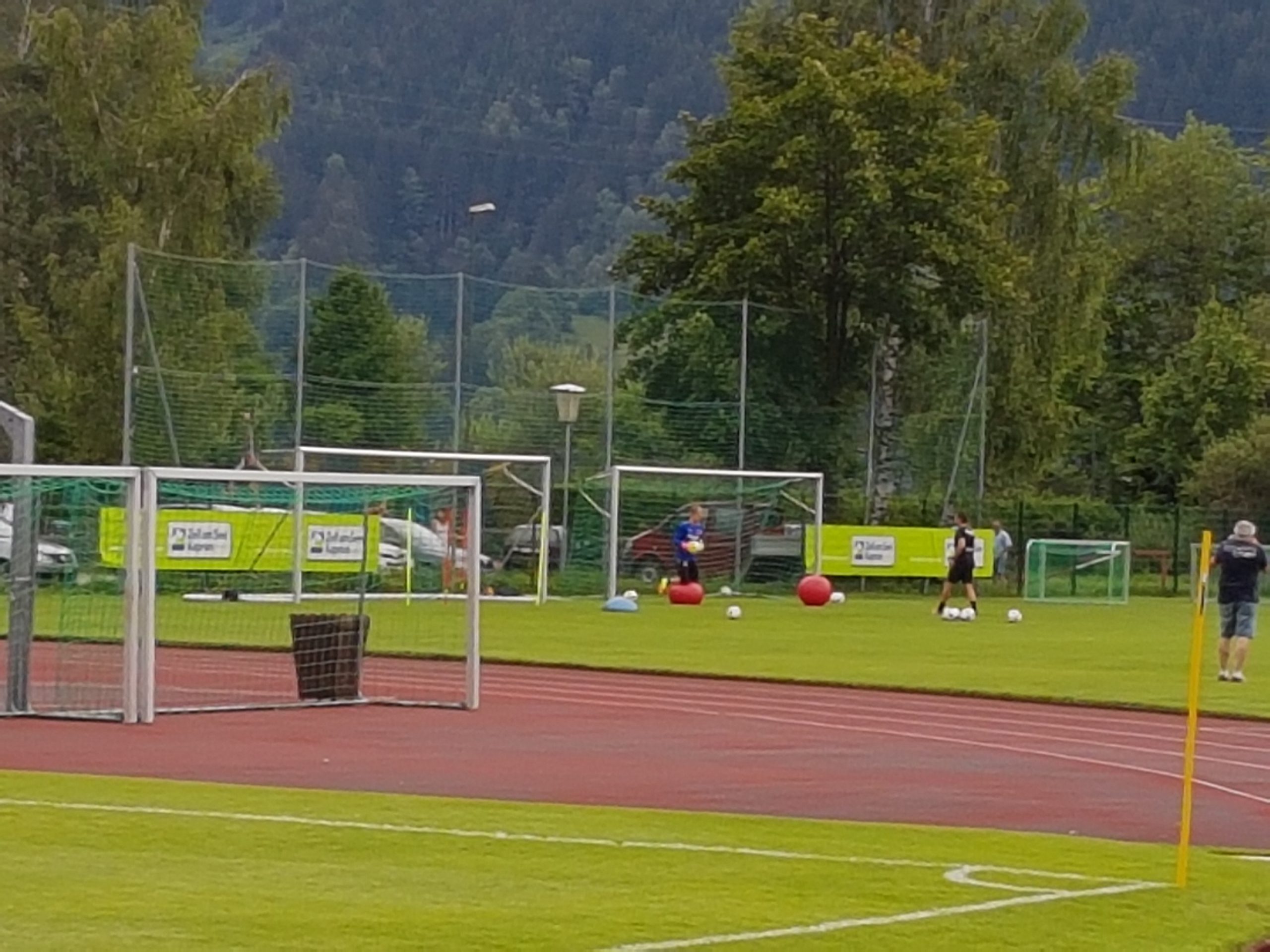
Balance and core strength is hugely important for GKs because they constantly find themselves in odd positions that they have to make explosive motions out of in order to make saves. Better balance also helps you become faster at making these dynamic motions, even when something has happened to mess up your initial positioning or footwork.
Also check out some of the sand pit work (around 1:35) in this video from the Ajax academy for some funky, creative ways to continue training balance at elite levels. Forwards are constantly getting battered by other players, and being able to continue executing while withstanding that sort of assault makes a huge difference in end product.
Two-Footedness
This is probably the most obvious hack on my list, but it happens far too infrequently. I think one of the major reasons is that is has to be trained young to take full effect, and professional academies rarely have access to children at this age. Because of that, the responsibility falls to parents and community coaches.
Having two good feet completely changes how a player can approach the game. It's hard to quantify, but it opens up the other half of their body, which in turn makes vastly more options available with every touch of the ball. More good options = more opportunity to succeed and maximizes good decision making ability.
Think of it from the perspective of the defender. If I know a player only has one useful foot, I can always key on that when trying to defend. It makes my life easier. On the other hand, if a player is running at me or likely to shoot, and he or she can use either foot with equal alacrity, my job is infinitely harder.
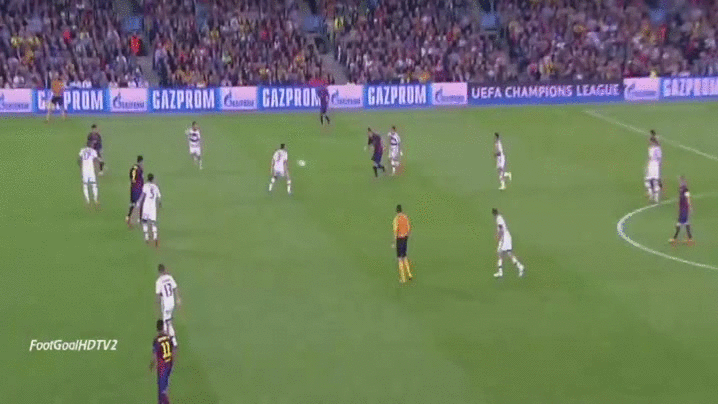
Having a second good foot also makes life easier for a player's teammates, since they suddenly have a much larger margin of error when passing to that player. I've run into two major difficulties in my own training of U7s and U8s in this area.
- You have to make the kids aware of the need to use both feet. It's also good to attach it to a player they really like and talk about how hard they worked to make sure both feet were good. (Santi Cazorla is my son's example.)
- You have to reinforce this need constantly.
Kids want to succeed.
As their dominant foot starts to get good, working with their weak foot feels like constant failure. Thus you have to talk about it in the same way as any other skill, but you have to mention it frequently, regularly, for years.
"Use the other foot! Now try it with your left! Pass it to the right, control with a touch, then shift it to your left to pass it back. Okay, now control with your left and shift to your right for the pass."
It is a long process, but... If you stick with it, you see your kids start to gain comfort. My son, who is an able U8 player but possibly nothing special, passes and shoots with both feet regularly during his games. He doesn't think about it either.
He's probably scored five goals over the last two years with his weak foot (his left), which never ceases to make me smile. We talk about why we train both feet fairly hard so that he understands it. One of the easiest paths to understanding was showing him how he could cut central much easier for better shots if he used his left foot as well as his right.
If you want to develop better footballers, you must impart the knowledge that this is important to your players, and find subtle, constant ways to bring it into training.
At the Pro Level
I was helping Flemming Pedersen (now technical director at Nordsjaelland) set up a Brentford B session last year and watching some players warm up. One guy, who was fairly well regarded, was only warming up with his right foot. I noticed and jokingly asked how many feet he had. "Two." At that age, if he's only warming up with one, the hope that a player can use both feet equally is probably dead. Start early. Reinforce it regularly. Constantly work it into training as a nudge.
Scanning
Scanning is the act of constantly looking beside and behind oneself on a football pitch. (Some coaches call this "shoulder checking", but it's a more comprehensive activity than that.)
To me, scanning is the single biggest skill that separates average from elite players.
It has also been heavily validated, so before we go too far, check out this presentation + paper from the Sloan conference back in 2013.
"The results show a clear positive relationship between visual exploratory behaviors (scanning) that are initiated before receiving the ball and performance with the ball. The best players explore more frequently than others and there is a positive relationship between exploratory behavior frequency and pass completion. The impact of exploratory behaviors is the largest for midfielders performing forward passes."
The first place I ever saw this highlighted was a video from AllasFCB about Xavi. I still get chills thinking about it, because in my mind it was truly this HOLY SHIT moment of new knowledge.
(See also: football epiphany.)
In the video, Allas shows just how often Xavi is looking around the pitch, without the ball. It is an insane number of times, like every other second for an entire game.
However, this activity is what powers Xavi's game. He had an almost otherworldly ability to see the pitch, find open men, find his own space, escape pressure, and complete impossible passes most players would never even see.
He could see these things because he was constantly looking around. When I first watched this video, my heart stopped.
I had been watching football for 15 years at that point, why had I never seen this?
It literally changes how you can see and play the game. One of my all-time favorite examples of this came during a Bayern Munich match from last season. Watch Xabi's head look to his left just as the right back receives the ball.
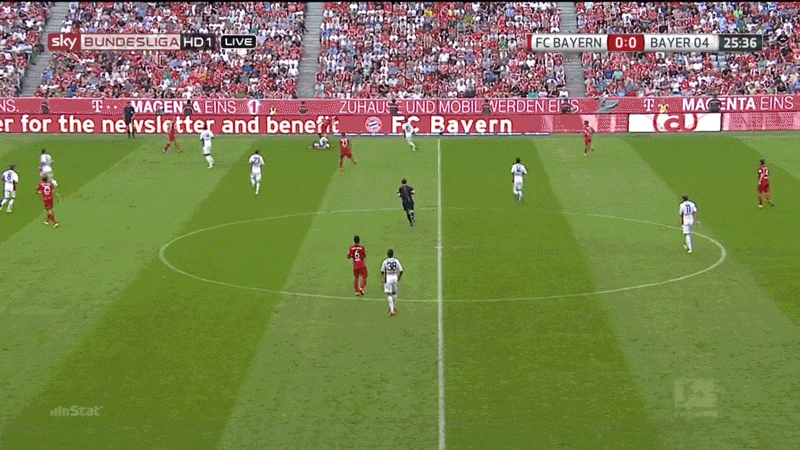
As part of his scanning, he spots Costa in space with only a fullback near him. It's an amazing pass, but that pass is created because his scanning made it possible.
Here's the thing - scanning is important everywhere on the pitch. Forwards need it to see who is around them, whether they can turn, where the space is, where they should run, etc. Midfielders need it for absolutely everything, since they are surrounded by opponents at almost all times.
Defenders need it to know not only where their nearest opponent is, but where their helping teammates are, where additional runners may be, and as you see above, where their potential passing outlets are once they recover the ball.
You want to teach your players to play one step ahead of the opponent?
Teach them to scan.
How best to train scanning?
I don't know.
This was high on my list of things I wanted to learn when visiting elite academies, but I never got to make that trip. I have some ideas on how to go about it, but have done zero work on best practice.
I asked a high level English coach how he would go about training it once and got the following answer:
"I learned to look around when they threw me into training with the big boys, because if I didn't, they'd kick holes in me. Teaches you right quick, that does."
We may have some issues with pedagogy in this country. Please leave links in the comments if you have information on how to train this at different levels, and I'll review them and gradually move the best of them up here as recommendations.
Cover Shadows
In my head, this is the inverse of scanning for the defensive side of the ball. It requires scanning to do well, but understanding cover shadows will help players dramatically limit passing options for opponents. Think of the ball as a light source. Bodies of defenders are solid, and they create shadows behind themselves.
Here's an image from Rene Maric that clearly illustrates the concept, and the grey shaded area are covering shadows for Iniesta and Xavi.
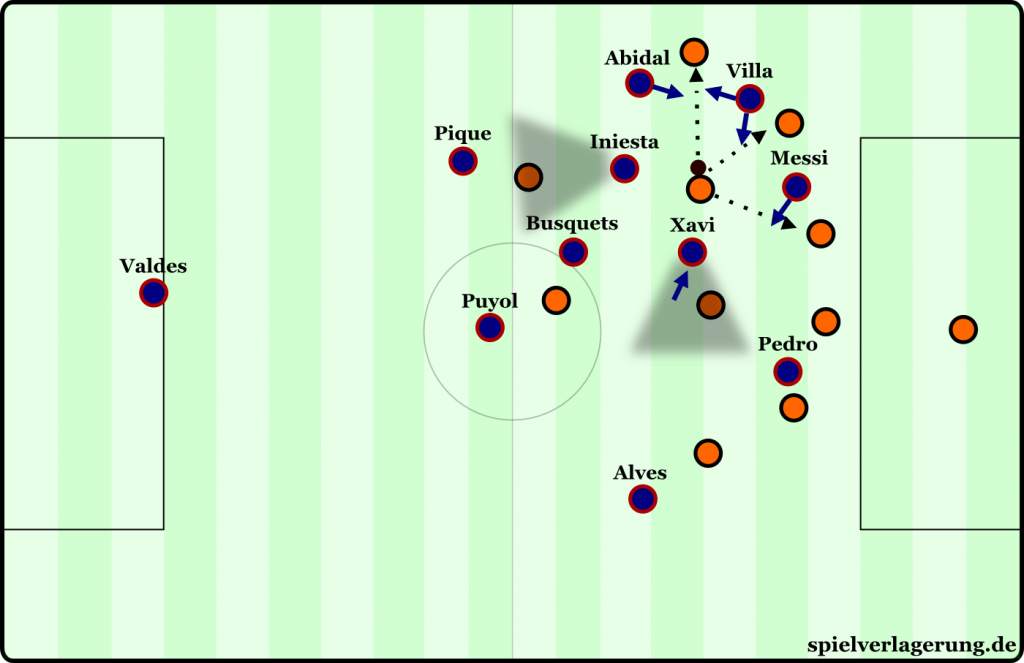
Why does this matter? Because it is a key to defending, particularly to pressing defense. It allows a player to not only press the ball, but also to limit a passing option at the same time. And it is a concept your attackers need to understand in order to work through a press from their opponents. Unclear? Check this out. Watch Aubameyang's sequence of presses here and in particular, look at how he cuts off a passing angle with a curved run each time.
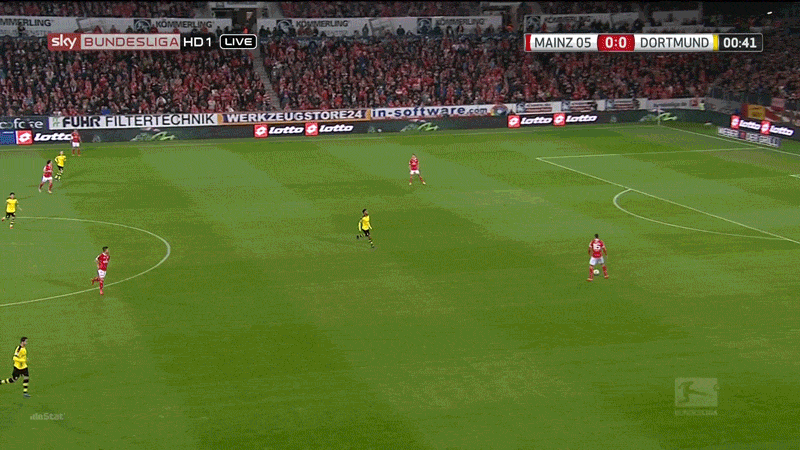
Then notice the creep (or sprint) on the other Dortmund defenders as they move forward and further cut off lanes like some sort of pressing python, strangling possession.
The result is a long pass into the distance, and likely Dortmund regaining the ball. I also like the explanations from Spielverlagerung about Atletico's press, which has a different flavour than Tuchel's, but the underlying concepts are similar.
That piece is crazy long, but example 1 is enough to get a sense of what I mean.
How do you train it?
It goes hand in hand with scanning and pressing. How do you train elite level pressing? What are the sessions?
What does the knowledge progression look like?
Sadly, I once again don't know.
As I mentioned in my How Coaches Learn article, coaching knowledge is very much an apprenticeship, and I have not been able to learn how to teach this to players from experts yet. That doesn't change the importance of the skill with regard to player development. It just means my ability to convey further knowledge to you is currently limited. Think of the following things slotting into place for your players:
- Scan the whole pitch in attack.
- Scan the whole pitch in defense.
- Work covering shadows aggressively.
- Form Voltron.
That's almost how it works. First you make one phase of the game far easier for yourself. Then you make the next major phase easier as well, and you make your transitions better in the process. Finally, you make attacks for the opponent far more difficult. The result should be a massive improvement on a possession by possession basis.
Wrap-up
To me, the four elements discussed above are the fundamental building blocks for developing better, smarter players. I don't know how to train the last two well, because they are specialized knowledge that I have yet to unlock, but I am absolutely certain of their value to modern footballers. Thanks for listening.
--Ted Knutson @mixedknuts
Post Script
This is another chapter in a book I have gradually been developing over the last year. It touches on all sorts of topics, but the main purpose is to explain how I view the game of football and why I think the way that I do.
I don't approach the game from the standpoint of someone who played - that wasn't an avenue that was available to me where I grew up.
Instead I approach the game from a standpoint of examining what matters, how do we prove that, and how do we apply these lessons to teams on the pitch? Currently finished chapters are linked below (and are all free), so have a poke around if you are interested in more.
Explaining and Training Shot Quality The Future of Football How Do Coaches Learn? The Death of Traditional Scouting New Tech Marcus Rashford and Young Player Development
NEW TECH and A Little Story About Neymar, Andros, and Eden Hazard
Football Analytics has a learning curve. That's great, because learning is a fun, though occasionally painful process. This summer I did a review of my past work, and there's some cool stuff in there from the early days along with some really boneheaded mistakes. It doesn't matter how smart you are - your work is not going to be perfect when it comes to something new. The trick is simply to get over it and do better next time.
Today, I wanted to talk a little more about what I learned regarding player evaluation while going from zero knowledge in 2013 to running worldwide recruitment for two clubs in 2015. As part of that, I'll introduce the new attacker radars in print for the first time, and I'll talk about three of the most famous players in the world: Neymar, Eden Hazard, and... Andros Townsend?!?
Learning Curves
One of the first things you do when looking at a new data set is immediately boil it down to the important stuff and focus on that:
What is correlated with [important stuff?]
What causes [important stuff] to happen?
In football, we care about goals. In fact, for some pundits, that's all they care about. The only number that matters is the score.
Imagine a classroom of ten-year olds talking through the data.
Alright children, today we are going to talk about football. Match of the Day and legendary England striker Alan Shearer said we care about goals more than anything else.
So the first thing we have to ask is, what causes goals?
"Shots, shots cause goals!"
Excellent, Timmy. You're too young to remember, but Alan scored an awful lot of goals back in the day.
Now if we take a step back and say we care about "scoring", which is actually a superset of goals, what else might we care about?
"Assists! Assists are passes that created a goal. They should count too."
Great. Now we have goals and assists. And let's find one more element to look at here - what do exciting players do a lot of when they attack?
"They uh... elbow people in the head?"
I know you like Diego Costa, David, but that wasn't quite what I was going for.
"They dribble?"
Outstanding Samantha. So lets see if shots, assists, and dribbling are a great start to finding players who score more goals.
End Scene
It's a bit forced, but this is literally what most people do when they start analysing football, which is great, because it's an excellent, logical process. There's one missing step in here going from assists to key passes, which is the functional equivalent of going from goals to shots, but that's it.
Want to find interesting attackers? Look at shots, key passes, and successful dribbles. Do this and good players start to magically show up at your doorstep.
For instance, take the numbers for these two guys...

We've isolated what we care about in attackers, and these two young guys stick out like sore thumbs. They are similar ages, and even play for bigger clubs in good leagues, so there are no worries about league translation or anything like that. Indicators are that Andros might actually be a slightly better player than Neymar, but they are both very good for their age.
Plot them side by side on the original forward radars and you get this.
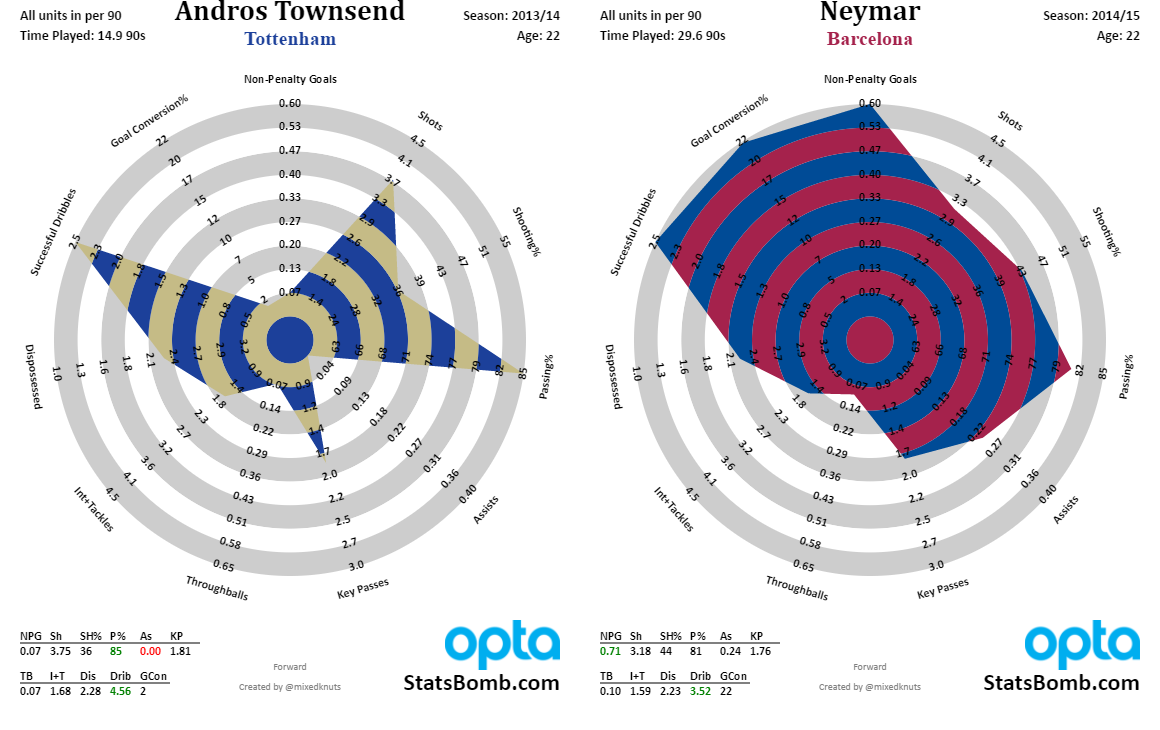
Given our earlier conclusions about certain stats driving scoring outcomes, this begs the question...
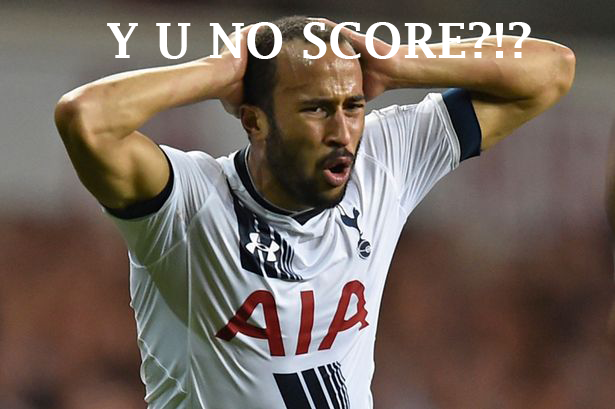
Looking at this objectively, there might be a flaw in our process. These two players have a lot of similarities in driver stats, but the thing we actually care about - scoring - is massively different. Were either of the players lucky/unlucky in their output? Is it a teammate problem? A coach problem? You can think of a million different possible reasons why scoring might be different, but guessing is unacceptable.
So we now go back to the drawing board to find more clarity. There are lots of ways to do this, but one of the simplest, most effective ways of going about it stems from one of the most important lessons you learn as a data scientist.
Always plot your data.
Here we take locational data for shots and add it to the MK Shot Map format... and you get this.
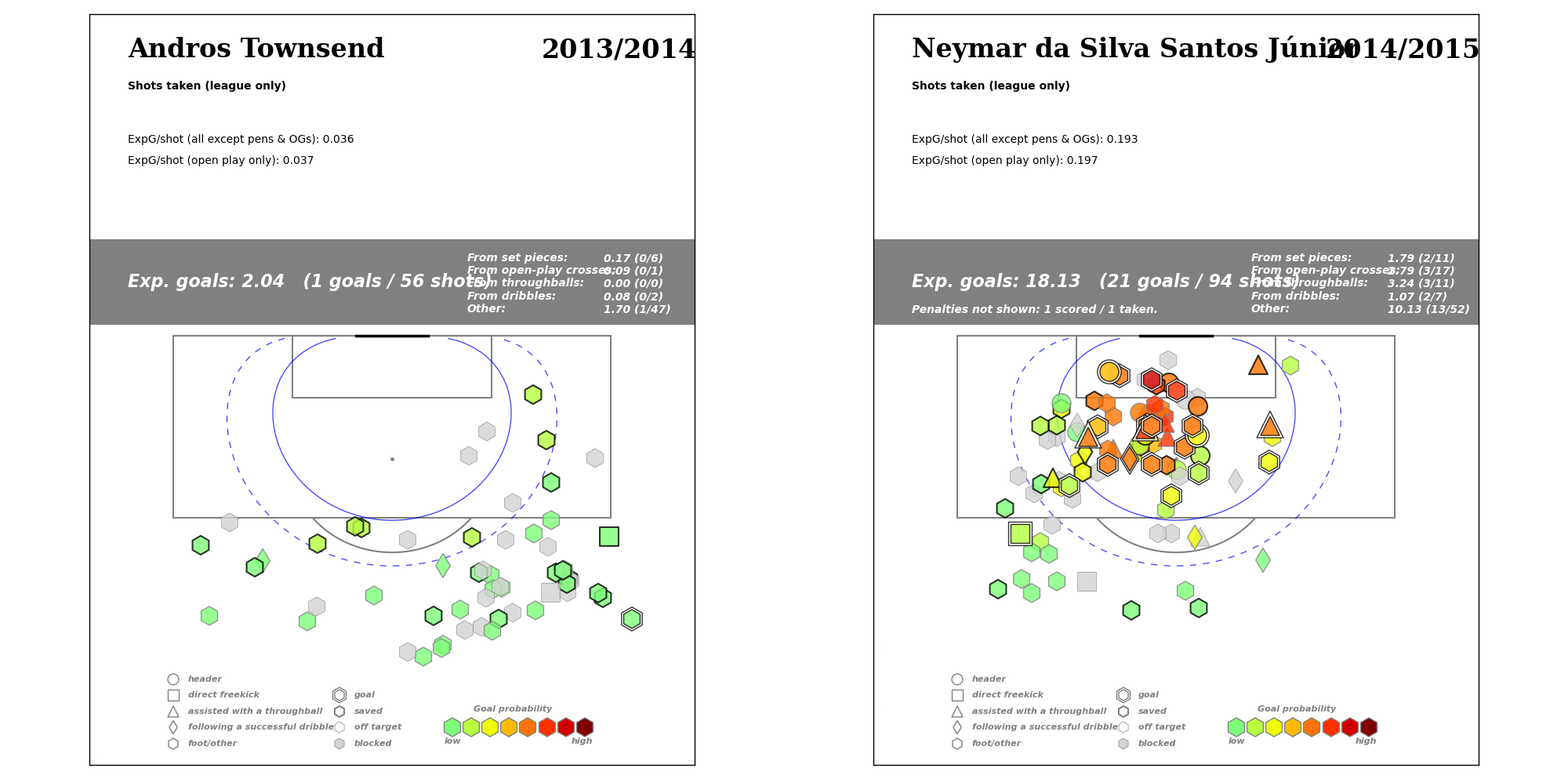
(click to embiggen. Made with Opta data)
Oh.
Oh my.
That's...
I mean...
It's as if someone put a force field around the danger zone shooting ring for Townsend, and he's not allowed to have the ball in that area. Meanwhile, almost every shot Neymar takes is from prime real estate.
The reason for potential problem we flagged up earlier immediately becomes clear.
So using numbers and visualizations, we have gone through a three-step advancement in the player evaluation process.
Step 1: These are numbers we care about. Let's look at those and see what happens.
Step 2: Visualizing them on the radar charts while normalizing them for the population shows that we might have a hole in our basic process. Was Townsend unlucky not to score from all those shots? How do we get more clarity on this?
Step 3: Visualizing the data on shot maps makes the problem crystal clear. Neymar takes great shots. Andros takes terrible shots. In fact, Neymar's expectation of scoring on an average shot is more than five times greater than Townsend's. This in turn has an absolutely massive impact on their probability of scoring a goal from any particular shot.
Other Holes in the Process - The Eden Hazard Problem
Obviously with attackers we care about scoring, but what about players we know from watching have a huge impact on the game, but for whatever reason don't show up very well in traditional scoring stats?
To put it another way, how do you find players like Eden Hazard? Hazard might have been the best attacker in the Premier League in 14-15, but his scoring stats weren't close to overwhelming.
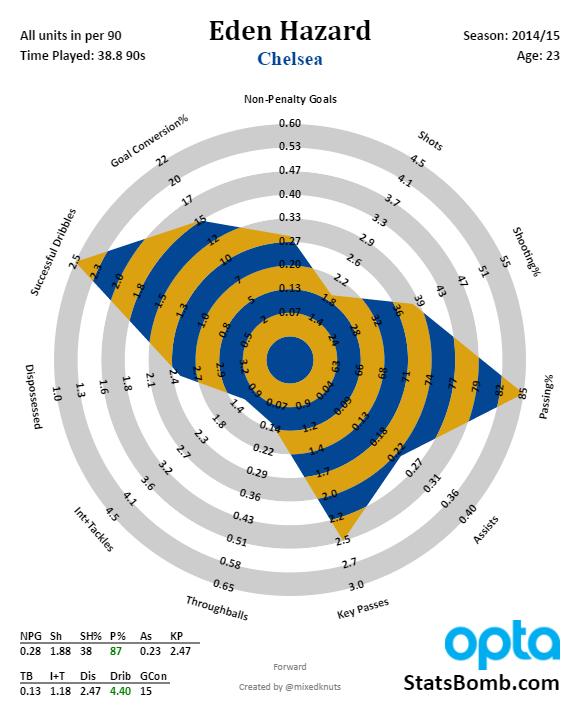
What can we do to tease out more data and find elite players who don't always directly contribute to goals or assists?
For me, the answer was to take another step back in the process. We look at key passes and shots and they matter, but what about the ability to generate successful touches inside the box? And since football is fundamentally a passing game, what about players who are able to make successful passes into the penalty box, which might be one of the rarest skills in the game? So I created two new metrics:
- PINTO = Successful passes in TO the box
- TINDA = Successful touches inside 'DA box.
It turns out when you start to isolate players by this particular combination of skills, you get a useful additional perspective on players who contribute to scoring, both directly and indirectly.

Thus a new format of attacker radars was born.
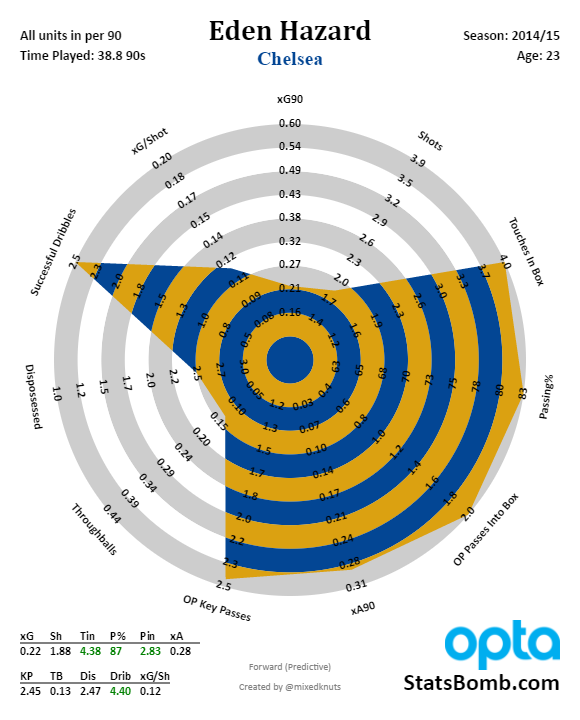
I called the new template "predictive" because at this point in my head, I was thinking of the old template as "narrative." The new template took a step back from narrative stats about what happened (goals, assists, goal conversion, etc), and started to use a few of the advanced, more predictive measures we'd developed since I created the early versions.
The new format more clearly illustrates what a monstrously talented creative player Eden Hazard was that season compared to the population of attackers.
(Note: OP stands for 'Open Play' which I get asked constantly on Twitter)
Finally, circling back to our initial comparison, this is what those Townsend and Neymar seasons look like on the new template.
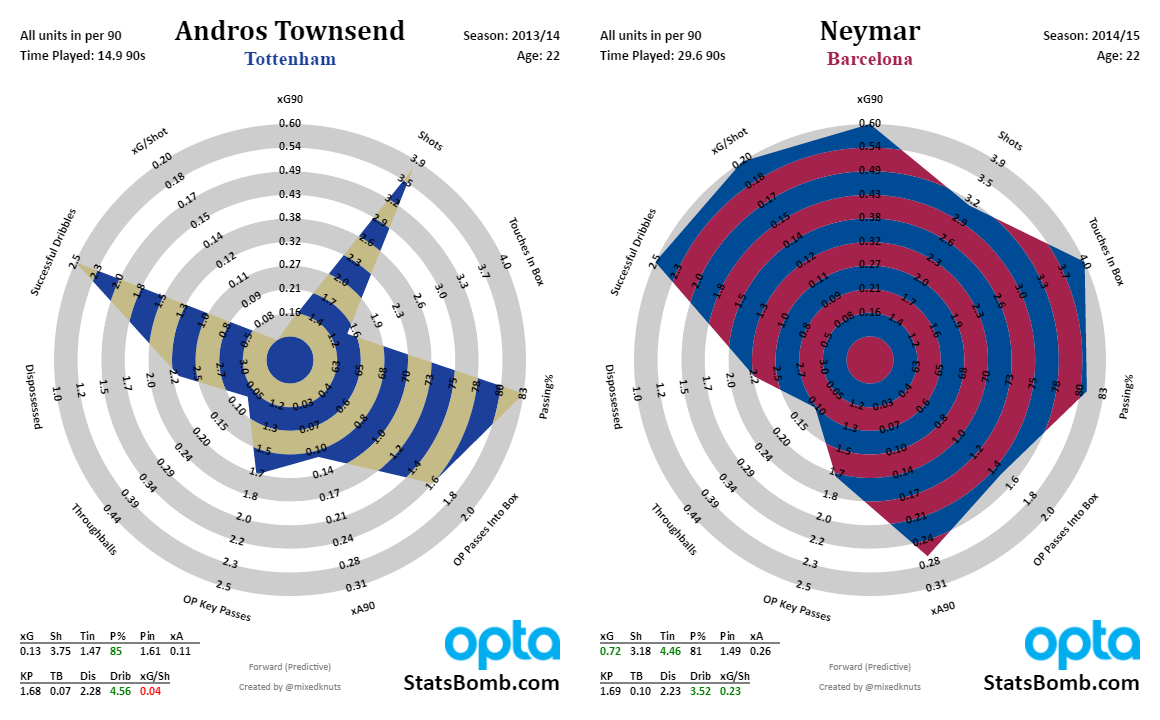
Conclusion
Learning how to use football data better is a process, but it's a worthwhile and rewarding one. The new radar format came about from continually asking questions on how to analyse the data better. Can we iterate and improve on old metrics?
The old format was good as a starting point, but the new format shows player value much more clearly. It also contains years of work and improved understanding about how both the data and the game operate.
It's also worth noting that even this "new" tech is 18 months old. If you are a club and interested in seeing some of the new stuff we've developed in the intervening months, drop me an email at mixedknuts@gmail.com.
The latest tech is both cool and extremely useful in helping your club make better decisions, both on the pitch and off.
--Ted Knutson
@mixedknuts
July Mailbag - Gotze and Nolito Analysis plus Discount Center Forward Shopping

Some football experiments do not work out. The Mario Gotze/Pep Guardiola experiment is definitely one of those failures. It reminds me a bit of the feedback from fans when Pep bought Cesc Fabregas and then tried to shoehorn him into the false 9 role at Barcelona. Fabregas actually did admirably in a completely new role for him, but no one is Lionel Messi, and that was a perception problem more than a performance one.
Gotze is probably at his best as a pressing 10 who can occasionally fill in as a creative wide forward when needed. What he is not is a center forward, and at this point it’s probably fair to say that trying to make him one has made Mario miserable, and given him perhaps the worst two seasons of his career.
I don’t think he was bad last season – 3 goals and 4 assists in about 1000 minutes is a solid return, and he’s still an outstanding passer and dribbler. On the other hand, everyone at Munich seems to want him to go, and he’s allegedly pissed off and being stubborn about leaving.
It’s clear to me he needs to get the fuck out of Dodge. My only concern is that he needs to go somewhere he wants to be, with a team and a head coach that will support him. Klopp might be the best option, but at a club level Liverpool is certainly a step down from mighty Bayern (don't @ me).
From the perspective of a buying club, you know he’ll be on big wages and has been a disappointment this move, so you’d negotiate aggressively for a lower fee while telling the player how much you want him. I think he’s a good buy if you can get the fee down to say £20-25M, provided he’s excited to come to your club. If he ends up at a port of last resort…

Probably £10 million, but it still depends on club. Arsenal could make a lot of £10M gambles and only wince a little when none of them pay off. A club like Burnley can only make maybe one before it really starts to create problems if they bust.
I was talking to another analyst recently, and we theorized that it might be impossible for Premier League clubs to get player deals with any "value" in them any more, strictly due to the fact that selling teams will hold out for much larger fees since they know everyone has money. Thus an objective value deal in real world terms becomes hard to find, but you can still find heavy "value" relative to the rest of the league, especially if you sell them to bigger PL teams down the road.

With that squad, I would probably not sign Nolito. People forget that money (in terms of fees and wages) is not the only scarce resource at a football club, so are minutes. I quite liked Nolito for the past couple of seasons at Celta, but City are O-L-D.
Aguero? 28. Bony? 27. Navas? 31 in November. Nasri? 29. Silva is 30. That’s just in attack and most of those guys have had injury issues in recent years. Kelechi, Sterling are young, KDB is peak, but as it’s composed right now, the majority of team minutes will come from players who are 28 or older. It’s tough to do that in the Premier League with CL and Cup commitments and succeed.
On the other hand, City just don’t care about the funds spent and if Pep wanted him, the price is low enough to just splash the cash and assume he’ll deal with any other issues. Nolito is a clever player and should end up as an outstanding super sub for the next couple of years, regardless of whether he’s good enough/young enough to spend a lot of time in a starting role.
I expect to see a staggering amount of money spent by the time City are done buying this summer. Pep’s worth it, but this would have been a lot easier if more forethought and planning had gone into squad composition in the previous 3 seasons.

Andre Gray was bought last season for a base of £6.25M (with good add-ons) and he’s probably PL quality. The new TV deal will inflate prices paid, but up until last summer, you could probably find players dotted around Europe who could play striker for you at £5-6M and expect reasonable success. Now that figure £8-10M, and there will be fewer undiscovered gems.
Recruitment is hard. Every team has similar needs and a lot of money now. This is why it pays to invest in being smarter about it instead of simply throwing more money at the problem and hoping you succeed.

This is quite difficult, and most clubs are naturally risk averse in this situation. If you don’t see the player play in a similar system to the one your club plays, the natural instinct is to assume they can’t do it, especially at the back. It’s a safe assumption, and I completely understand the choice, but it’s not always the best one.
Some clubs will break this assumption for special players or when their options are dwindling and they are forced to make sub-optimal choices. The point here - like I mentioned above - is that this is hard, and it actually makes sense to be cautious because if certain players fail tactically, the whole system can fly apart.

I started doing this work back in summer of 2013 with Manager Fingerprints because I wanted to start profiling managers in a similar way to what I was working on for players. Since then, the process and KPIs have been improved dramatically, to the point that we can identify tactical style, strengths, and weaknesses in the data for each manager/head coach and give some advice on whether they will succeed.
Manager failures are EXPENSIVE. Not only do you need to worry about paying out the rest of their contract, you also have to pay off all the staff that each new manager brings with them. Doing as much objective due diligence as possible before each hire just makes sense.
At the very least, this information highlights some very interesting interview questions you would want to ask every coach as part of your hiring process.

I asked a couple of follow-up questions to Bobby to give me more information on this one. He says we’re probably looking at a possession-based 4-2-3-1 with Gylfi playing behind the striker, so ideally you want someone with some pace, who can hold up the ball and pass reasonably well, and who won’t get destroyed by PL centerbacks. Tricky stuff, especially trying to fill two positions for only £25M, but we’ll see what we can come up with.
Two guys that I would have included, but whose price tags skyrocketed recently are Vincent Janssen (off to Spurs for 22M Euros) and Manolo Gabbiadini (West Ham allegedly in for him at £20M). Money still matters for at least part of the Premier League.
Most of the ones that I propose below are low risk type buys. There are others that are higher risk, but a) they are less known and b) your scouting department would have to be really happy with them before you make the leap.
Option 1 – Borja Baston
Current Owner: Atletico Madrid
Age: 23
Estimated Price: £12-15M
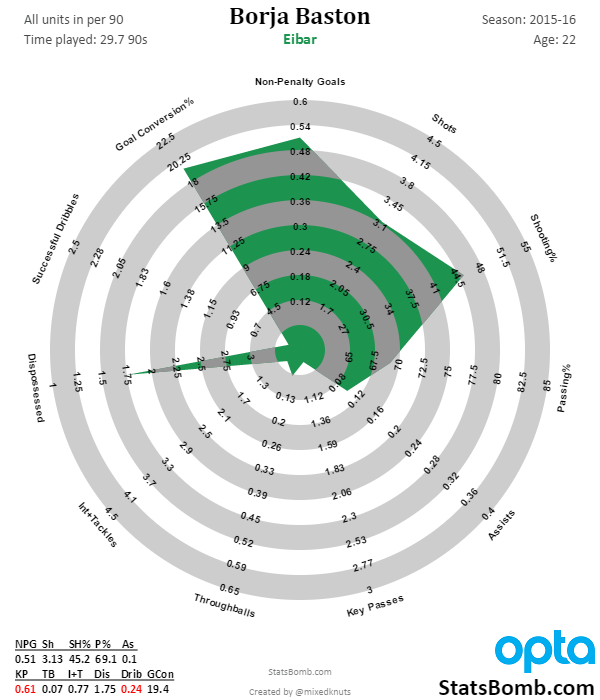
I spotted him in Segunda last summer, but the price tag was north of 5M Euros, which was not a fee my previous employer was willing to pay, and he wanted to play in a top league anyway. He did that last season on loan at Eibar in La Liga, banging home goals exactly like he did a league below. La Liga is the toughest league in the world right now - if you score there, you are definitely talented.
Age is right, production is right, body style is right. I suspect the only real question is whether Atletico want to keep him in the fold for next season.
Option 2 – Sebastien Haller
Current Owner: Utrecht
Age: Just Turned 22
Estimated Price: £8-10M
A bit less heralded than Vincent Janssen, he played on a slower-paced team than AZ, but still put up impressive goal and assist numbers the last two seasons in the Eredivisie. Pace is solid for a big man, and I love his ability to pass around the box. He had two assists late in 14-15 that were jawdropping. The usual stats might not look amazing this year, but I have pretty strong reasons I can't explain for why I am still high on the player. His highlight reel is exceptional.
Option 3 – Andrej Kramaric
Current Owner: Leicester City
Age: 25
Estimated Price: £12M?
An elite scorer in Croatia, Leicester snapped him up for somewhere around £7.5M in January 2015. Kramaric did quite well at Hoffenheim on loan last season after struggling a bit at Leicester. I think they pulled the trigger on him too quickly though and…
What do you mean already Leicester SOLD him to Hoffenheim for a tiny profit on what they paid?
Goooooddammit.
NEXT!
Option 3.1 - Luuk de Jong
Current Owner: PSV Eindhoven
Age: 25
Estimated Price: ???
“Didn’t he fail at Newcastle and Gladbach?”
Sort of… hear me out.
Newcastle have been highly dysfunctional behind the scenes for years. They seem to destroy good forwards on a yearly basis, meaning they either have huge flaws in their recruitment process OR the club itself has systemic issues. Seeing as how they have been relegated again this past season, I’m going to go with the theory that it’s more Newcastle and less Luuk.
Meanwhile he has been fucking great at PSV, winning back to back titles and making the knockout rounds of the Champions League. He’s averaged 23 goals and 9 assists the last two years and totally deserves another shot if you can negotiate a reasonable price for him.
Maybe he’s happy in Holland, but I think he’s good enough to play in a better league, on a stable, more supportive team.
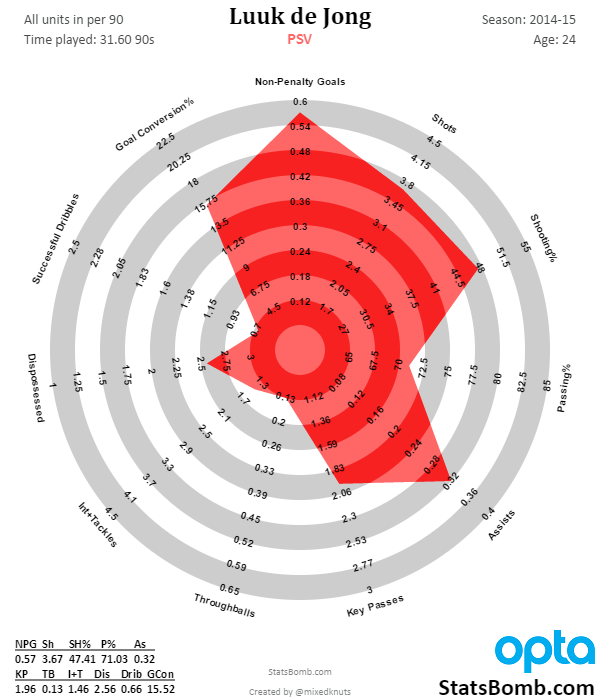
Wissam Ben Yedder
Current Owner: Toulouse
Age: 25
Estimated Price: ?? Figuring out what Toulouse will sell anyone at is difficult and I have zero guidance on this aside from saying he only has 1 year left on his contract. Definitely less than £10M.
Ben Yedder was on the original list of attackers I reviewed way back in summer of 2013 and he’s been a great little value forward ever since. Goal scoring is consistently decent to good in a team that has been almost relegated two seasons in a row. One of the things I love is that he averages about .2 expected assists a season, which means he probably won’t screw up a possession game around the box.
If you are looking for a solid performer, especially as a PL backup, I think you could do a lot worse than Ben Yedder.
How Do Coaches Learn?
How do we learn a thing? If you are in any normal pursuit, you probably read a book, or take a course. Maybe you check out some peer-reviewed journal articles, should you have access to materials at a university. Possibly, what you want to learn has some expert sites on the internet, so you trawl through their material to get up to speed. In a few rare cases, maybe you are lucky enough to have access to a subject matter expert and you ask them for information.
That’s for normal subjects, which covers the vast spectrum of all things humans need to know.
Now… how do you learn if you are a coach?
This is a question that has fascinated me since I started working inside of football, not least because I needed to figure out the best ways for me to impart my knowledge to coaches for them to use. So I started studying the problem inside of our clubs, and also took the English FA Level 2 Coaching Course to see how new coaches learn from a personal point of view.
What I figured out is this:
How coaches learn is
- an unbelievably important thing for people who work high up in football to know.
- horribly misunderstood by almost every decision maker I have encountered.
It’s not really anyone’s fault – it’s just that picking up coaching knowledge is so different than how humans learn almost anything else, it’s easy to make assumptions that seem natural, but are quite clearly wrong.
The issue here is that unlike almost every modern profession in the world, coaching is really an apprenticeship. Instead of learning via reading or attending lectures, the vast majority of knowledge you need to do the job comes via observing and doing. Theory is still important, but the practical element is dominant.
Before we carry on, let’s break the job down further – what do coaches actually do?
Choose a style of play for their team.
All the potential styles of play under the sun are possible, both in attack and defense.
Design training sessions to impart knowledge to their players about the style of play and specific tactics.
Once you have chosen how you want your team to play, you need to teach that to the players through training.
Teach. Communicate.
These elements are huge. If you can’t teach and communicate your ideas in a clear and effective manner, then you aren’t likely to be a good coach. And the subjects you need to teach to players are potentially vast and hugely different, but cover all areas of technique, tactics, phases of the game, and dynamic situation analysis of yourself, your teammates, and the opposition.
Football is complicated. That’s one of the things that makes it so captivating.
Interventions.
So much of what a coach actually does in training is correcting things that are not quite right, or teaching players about the options they had available. A teachable moment occurs, the coach stops training, rewinds to what they want to discuss, and then corrects actions to how they want it done in the future.
Conduct meetings.
These meetings can cover a variety of topics including reviewing training, reviewing games, what to expect from upcoming opponents, teaching new tactics, etc. You only get so much time on the pitch each week as a coach, and then everything else you need to give your players comes outside that area, typically through video review. That means meetings, and at the professional level, potentially lots of them.
These are just the basic elements of the job, but there are plenty additional responsibilities I have skipped over for the sake of brevity.
Right, so now we know what coaches do – the next step is learning how to do it.
In order to teach the material to players at an elite level, you have to master the material yourself. Where does that mastery come from?
- Playing the game. It’s possible you picked up some coaching basics via osmosis when your brain and body were busy learning how to play.
- Learning from past coaches you played under. Most of these will not be role models for the modern game, especially if you played in England.
- Coaches you apprentice under as a lower level, or assistant coach. Most new coaches land at their early jobs not based on what those jobs can teach them, but based on the fact that those were the jobs they could get. How many of those will be great learning environments?
- Coaching courses and licenses. In many cases, you are required to go on these to maintain your licenses. Like many courses in other pursuits, some are useful, some are not.
- Internet resources. Useful, but a mixed bag of material and rarely comprehensive.
- Watching other teams play? With regard to this one, how do you go about seeing tactics in game situations and turning them into training sessions for players?
Without belabouring the point too much, coaching is a knowledge-based profession that is also a practical apprenticeship, and it’s incredibly hard to find a good place to learn how to do it well.
Let’s step away from coaching as a whole, and make this simpler... Say I want to learn how to train a single tactical element from top to bottom, and do that well. Pick one item from the following list:
- Defensive pressure like Jurgen Klopp
- Generate great shots like Arsenal
- Execute set pieces like Atletico Madrid
Awesome, we have a topic… now what?
Uh… I don’t know?
You can’t exactly walk up to The Jurgen Klopp School of Football Coaching and get a degree in Rock and Roll Gegenpressen.
And as far as I am aware, there is no Arsene Wenger MBA of Elite Attacking on offer at any university in England, nor Cholo Simeone’s Science of Set Pieces anywhere at all.
This is unfortunate, because as a student of the game and someone who actually needs to know a lot of this stuff to be better at his job, I would enroll in this as an Executive MBA program in a heartbeat.
It sounds like I am joking, but this is serious stuff – if you are a young British coach that wants your team to learn German-style defensive pressure, how do you do it? Where do you do it?
The basic unit of coaching is a training session. Where can I find 10 or 20 or 30 training sessions strictly on imparting the knowledge of zonal defensive pressure and gegenpressing, explained in detail?
And more importantly, where can I find the video of those training sessions, so that I can learn what right and wrong look like in training, and be able to make crucial interventions? Because that is what you need to have in order to learn the material well enough to teach it to players who are unfamiliar with the concepts. You need example after example of what is right and wrong, and an expert pointing these things out and explaining the difference.
This isn’t just a personal lament – I’m writing about it because it explains one of the incredible oddities of the football world:
coaches almost never change styles.
This is weird, right? Coaches are typically smart, and football is a dynamic game that changes tactically on a regular basis. So why do so few coaches go on to incorporate other styles or develop new ones over the course of their career?
- As noted above, it’s hard to learn a new style in the first place.
- Where and when are they going to test out that style while learning it?
Successful learning environments are low pressure, where students can make and learn from mistakes while getting feedback. Making mistakes (and reviewing them) is fine because that is how we learn, especially in a hands-on, process-oriented job like coaching.
All first team coaching jobs in pretty much every professional league in the world are high pressure environments. You’re a first team coach – your job is to win matches. If you don’t win matches, you will be replaced. Period.
These two things are wholly incompatible. Being a first team coach means you exist in a terrible learning environment.
Additionally, when pressure increases, we tend to revert back to what we know and think works best. Which in coaching terms will be the tactics you are most familiar with from your historic learning journey.
Thus is it any wonder that we rarely see professional football coaches learn new things? For most of them, their job makes for an environment totally inhospitable to experimentation, which is crucial in the pursuit and mastery of new knowledge.
THIS IS A HUGE PROBLEM!
Say you want to hire a new head coach because your old one was too successful and has been poached by a bigger club. You find a new coach whose personality works, who seems open to new things, but his past teams have only exhibited two of the four crucial components to your club’s style of play. What do you do?
“Well, [new coach] can learn what they don’t already know.”
Maybe. Probably not.
Definitely not if this change is happening in-season, or if the job is a high pressure job – as pretty much all of them are. Even if they want to increase their knowledge, it might not be possible because the learning environment is toxic.
At the end of the day, understanding the problem fundamentally changes how we address it.
Instead of “[new coach] can learn what they don’t already know” decision makers need to ask the following: “How do we enable [new coach] to learn what we want them to know?”
New coaches are what they are. Do not expect them to fundamentally change on their own – we have an overwhelming amount of evidence that indicates that doesn’t happen. Instead you need to think about empowering them to learn and provide subject matter experts to bolster their knowledge.
So How Can a Coach Learn New Things?
- Spend time interning with coaches who already know these things. This would presumably involve going to watch training with other clubs during the off season. The problem here is that most coaches are secretive about their training and tactical knowledge, and the off season happens at the same time for practically every club in Europe. Where and when would you do this?
- Hire assistant coaches that are subject matter experts. The obvious example here is hiring set piece coaches to coach your set pieces, but it can be true across the whole spectrum of coaching expertise. In American football, there are coaches for each specific football role (Quarterback, Offensive Line, Running Backs, Wide Receivers, etc), as well as coordinators who sit on top of offense, defense, and special teams and who all report to the head coach. These act like coach-analysts I have mentioned in my previous work, and can be more hands on with players about every aspect of their games. Want to implement a defensive press? Hire a bright, young defensive coach who has expertise in this area to work inside of your coaching staff. Hopefully the personality and linguistic differences work out fine, and everyone ends up happy. That last bit is tricky, but people need to make it work because it’s one of the only possible ways to add new knowledge to your club.
- Create training programs inside your own club to address these areas. As I noted above, there’s very little public learning material that can turn you into an expert in specific tactical areas, or even to give you the basic paths for learning the information. That doesn’t mean it’s impossible. If a club wanted to, it could go out of its way to create courses that teach the various elements of its style of play, complete with instructional videos, videos of past training, session plans, and written explanations that tie it all together. Make no mistake, it’s a lot of work to create something where nothing existed before. But if your club has taken the time to develop a style of play it thinks is important, doesn’t that deserve the investment necessary to make sure every coach inside the club can learn all of the tactical elements inside of that style to an elite level? Including incoming head coaches that may only have parts of the knowledge you need them to have?
It comes back around to this: football is a knowledge-based game. Smarter coaches and smarter players equal smarter results. And yet our ability to increase coaching knowledge is somehow incredibly limited.
Remember, it’s not just book learning we are talking about. It’s learning the material well enough to communicate it to other people. It’s seeing the situations in training and on the pitch, recognizing they are outside the ideal, and then correcting them in a way that the player can understand and that makes them better for the future. And it’s reviewing training and game performance to figure out what is missing, so you can implement and adapt future training sessions to address that.
There’s one more big thing that is missing, even from the points above: reps.
In any new learning, it’s important to be able to practice a skill repeatedly. The more you do it, the more situations you see, the broader the knowledge base you build for what does and does not work in those various situations. If you are a professional coach who wants to add new tactics to their bag of tricks, how do you get the training and game reps to improve your learning and cement the new knowledge?
I don’t actually know the answer to that question, but I do know it’s important.
Head coaches already have too much on their plates at most clubs, but maybe the assistants can also coach academy teams in order to gain experience in tactical evaluation and organization cycles? Regardless of my inability to provide an acceptable answer, it’s noted here because it’s another important element that needs consideration.
Conclusion
- Coaching is a different type of profession than most of the world’s occupations.
- How coaches learn is radically different than how most people learn to do their jobs.
- Decision makers need to understand these facts. If they don’t, they have expectations for what coaches can and cannot do that are unaligned to reality. This gets expensive when teams are constantly firing head coaches and bringing in new ones in attempts to fix perceived inadequacies.
- Resources for learning new tactics and how to teach them to coaches and players alike are scarce. This makes learning new things somewhere between difficult and impossible.
- If you want to have a coherent style of play from one coaching generation to another, then clubs need to make sure they take steps to enable and empower new coaches to learn their style of play at an expert level.
Good Ideas and Lessons Learned
We are coming up on the three-year anniversary of StatsBomb. During that time (and despite a lengthy absence due to that whole "working for football clubs" thing), I have published more than 200 items in the SB article database. Plenty of these are fluff, like gifolutions during the World Cup, or weekly follow-ups on basic predictive models from back in the day, but plenty of these are early prototypes for concepts I would later successfully apply inside of football clubs.
Given the fact that there are a lot of new followers on my Twitter account since I started writing, and the fact that so many people seem to have missed the early years of football stats writing, I figure now is a good time to review my recent past. I’m just going to do it on my own work for now, which will keep me out of trouble for criticizing others work, and probably keep this to a (barely) manageable load. This is also just StatsBomb based and skips over work I did for The Mirror, The Guardian, Opta, and various guest spots on blogs over the years.
Doing this completely chronologically is going to be a mess, so I’ll break them into subject headings and then work from there. I'll also add some context about why pieces are included here, how I feel about them years later, and what stuff was just plain wrong about.
All of the material here is me learning publicly, and then writing about it on the fly. There is plenty in the early work that is just wrong. Given that knowledge, there is probably plenty in my current work that is also wrong, but hopefully it's at least a little less wrong than I was before.
Fundamental Work
How Do Teams Create Better Chances? Three years later, almost all the ideas in this piece still guide my thinking about football as a whole.
Pace and Margin for Error Early on, there was a lot of application of hockey metrics to football, spurred on by really interesting work from Gabriel Desjardins, James Grayson, and StatsBomb co-founder Benjamin Pugsley. One of the primary metrics used was TSR or Total Shots Ratio.
As of this article, I was having a really weird time applying TSR to football outside of the Premier League and La Liga. There are a variety of reasons for this, but a big factor in that is this concept of pace. It's around this point I stopped using ratios at all, even in basic shots work, and moved to differentials.
Building Better Defensive Metrics - Opponent Passing
I mention this one because I think I was the first to publish about it (though I suspect some clubs used it ages ahead of this), and also because it's not defined as "pressing."
Pressing is a set of actions designed to put pressure on the ball and yield [things]. Elements of success can be found in defensive actions, but not all successful pressure yields a tackle or an interception. Without tracking data, teams need to collect explicit data outside of the normal Opta event data set to examine pressing in detail.
Lower opposition passing percentages are a result or outcome, and can be caused by a variety of factors including tactics, player ability, pitch, weather, etc. It's correlated to pressing, but it's not pressing in and of itself.
If you want to examine team pressing beyond the occurrence of defensive actions in specific places, I would look at PPDA from Colin Trainor and Defensive Distance from Garry Gelade as well as opposition passing percentages. Introducing Possession-Adjusted Player Stats I still use these, though some find them controversial (and others pointless). There are probably better ways to go about it now, but it gets complicated pretty quickly and you need to be a data ninja to do the analysis.
Long story short, it's one of the few ways you can make defensive actions apply to things you care about with per90 data.
Explaining and Training Shot Quality
One from the post-Brentford and Midtjylland era, this piece is actually a chapter from a book I will likely never publish. It took a year of working on the ideas to get to this final incarnation. It's also based off the work of countless other people who went before me, and is not groundbreaking. The focus here was instead on clarity and brutal practicality.
If you didn't understand the concept before, it's a good introduction to shot locations and expected goals and covers a lot of the various forms of pushback I received on these concepts inside of football. If you already knew about expected goals and the like - which at the point of this writing is not nearly as widespread in football as analysts and even some journalists seem to think - it provides practical, real-world examples on how to teach these concepts to players in training and through what behavioral economics would call a nudge (the shot rings).
Increased data use in football is inevitable. This piece uses a Big Short metaphor to explain why.
Data Visualization
Radar Love: The Three Best Players in the World
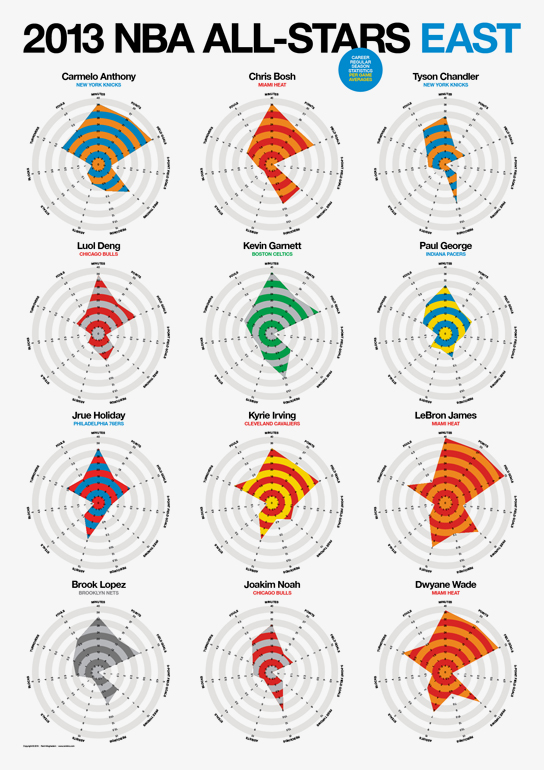
It started out with seeing an NBA All-Star poster by Ramimo. It ended with months of reading up on data visualization and learning Photoshop to finally produce player radar charts. This is the first, mostly awful piece that introduced them.
Iteration would then come fast and furious. I split the radars into positional archetypes and added two standard deviations for the boundaries (A.K.A. scienced the shit out of them), and voila - lovely little bite-size player evaluation pictures for the footballing world.
These have been improved in subsequent years, but the public versions are mostly the same as what I was making at the end of 2014. The new versions are only available to paying customers, largely because there are proprietary metrics in there and of which there are currently exactly none.
And if you hate them, you have my apologies, because they seem to have spawned a variety of imitators not only in football, but across various sports.
A guide explaining radars and how to read them can be found here.
Called "MK" because Marek Kwiatkowski did a lot of the heavy lifting for these, and there are many different variations of shot maps out there. The design diary for how these were created is here. The link above is a more practical use demonstration for using them with teams. You can also use them in player evaluation.
In terms of taking stats and applying them to football in a useful, beautiful way, I think these are at least as successful as the radars, if not better.
Player Evaluation
Opening the Door to Player Analytics in Football The first article I ever wrote about player stats and football. It all started with Max Kruse, who would go on to
a) Play in the CL and EL
b) Make a final table at the World Series of Poker
c) Leave £60,000 cash in the back of a taxi.
d) Allegedly get in trouble for his late night poker life style and eating too much Nutella.
Age and Value in the Transfer Market
This is hugely important and hugely misunderstood. I stand by taking Manchester City to task for their transfer buys in 13 and 14 not because of the immediate impact, but because it cost them heavily in the latter years of those contracts. Good thing FFP is irrelevant or they would be in a world of hurt trying to rebuild for Pep this summer.
What if you wrote a piece that read like good analysis but was completely wrong? Well, I totally did that and it looks just like this one.
The reason why it was wrong was a fundamental misunderstanding of the game at this point on my part. You see, I had been sucked in by the "all shots are equal" mentality of hockey analysis. The problem here is that while hockey and football overlap in many places, shot quality is one where there is a massive divergence. I didn't understand that yet, and because of that I thought Suarez kept killing Liverpool attacks by taking poor shots.
Not exactly...
The good news is that being wrong about this forced me to rebuild how I evaluate the game from the ground up. The bad news is that this mis-step blew up some of my credibility (especially among Liverpool fans), and I got to hear about it constantly both on Twitter and on the podcast from Pugsley. *sad trombone noises*
Midseason Transfer Shopping: Arsenal
It is January 2014 and Arsenal need a new forward. I poked around the data to look at Draxler (hot in the media), Griezmann, Lacazette, and... Aboubakar? This sort of statistical shopping (but using more advanced, modern metrics) is immediately applicable at the club level.
The Danger of Predictions - Luis Suarez Edition
I am public with my work and I'm not afraid of being wrong. If you make a lot of bets, you will get winners and losers. If you make a lot of player and team predictions, you will get the same. However, when you are wrong in this big a fashion, you are going to have to eat it. It was a great learning experience, and obviously I would not make the same mistake again.
Life lesson: If you are going to have to eat shit, don't nibble.
Statistical Scouting Young Superstars
Can we take statistics and use them to find young players that are going to develop into Champions League players? This research would consume the rest of my summer until I was hired by Smartodds, and to some extent still does.
A huge challenge, but hugely rewarding if you pull it off.
The Best Young Prospect in Europe 2014 - Alvaro Morata
I had Morata number 1 and Memphis number 2 that summer for very young players that would likely be future stars. Number 3 was Lucas Piazon, who has had some serious issues in his personal life and looks like a complete bust.
Trying to predict the future is tricky, and there are absolutely, positively going to be failures. On the other hand, something like half of all transfers of mature players "fail" as well, meaning you don't have to raise the bar that much to improve a Premier League club's transfer business enough to save tens of millions of pounds yearly.
The Death of Traditional Scouting
You would think someone who is a huge proponent of statistics would have strong feelings about traditional scouting. You would be correct. The article is adapted from a presentation I gave to Science + Football that encompasses two years developing a lot of the initial concepts you see written about above, but applying the theories inside the world of football.
It also explains why we almost never scouted players live at BFC, and how use of stats is pretty much the same as incorporating video services into your scouting, something that isn't remotely controversial in the modern day.
The unexpected take away at the end (which is the fault of the clickbait title) is actually that good scouts are extremely valuable, but most football teams can apply their skills far better than they currently do.
Arguing About Marcus Rashford and Young Player Development
A synthesis piece about player analysis and young player development. The second half talks about what clubs can do to better evaluate prospects coming from their academy and into the first team, which is yet another area I think most football clubs can improve dramatically.
Tactics
Attacking Wrinkles - Manchester City and Barcelona
I really like these types of articles, though they are a massive time sink to produce. I think the reason I get so excited by them is because it felt like doing real football work, and it definitely paid off once I needed to do presentations to coaches and Directors of Football inside the clubs.
Here's the transition from football fan to coach-analyst: Start to see games in sequences of possession. What do smart teams repeatedly do with the ball, immediately after they win it back? In the final third? What do they do immediately after losing possession? How can we further break that down into potential ways to train it on the pitch?
Thoughts on Football Clubs
Building a Better Football Club
Richard Whittall had written a piece for 21st Club about Directors of Football, and I wanted to apply some consulting knowledge to football clubs in general and see what turned up.
The essential logic is this: it's nearly impossible to know everything you need to know and have enough time to accomplish all the things a "traditional English manager" must do in modern football. And this is especially true when you realize the average life span for this role last approximately 12-15 months.
In short, it's a recipe for failure.
Merging Football Stats and Coaching
What happens when you goof around with ideas about how to better train players, at the same time grabbing their attention and imagination, while subtly trying to explain analytical concepts? You get this.
It might be too dumb to be useful, but I would love to have license to test it enough to find out.
Manager Evaluation
Introducing Manager Fingerprints Both of these articles are the building blocks for me trying to find a better way to evaluate managers than results in the league table. This work got much bigger and better once inside of the football clubs, and I'm pretty confident that - much like for player transfers - the data we analyze now will produce a better population of potential future head coaches for clubs than current hiring practices.
Conclusion
I hope you have enjoyed this look back through material both old and new, correct and horribly wrong. Football analytics is just like any other endeavour - mistakes will be made. The hope is that you also manage to get a lot smarter in the process.
Arguing About Marcus Rashford and Young Player Development
If you follow football Twitter at all, you’ve probably seen commentary about Marcus Rashford’s ascent to the English National Team. There are two fairly clear sides in this argument.
Side 1: Hey, look at this amazing young Manchester United player who can’t stop scoring goals!
Side 2: He’s been really lucky to score as many goals as he has so far. Statistically, there is little reason to think he’s as good as his goal return suggests, so should he really be going to Euros?
I was intrigued by the stats argument for a lot of reasons, not least because I hadn’t seen anyone actually examine whether it was true outside of some hot takes. Additionally, I figured it was a topic that would let me discuss young player statistical development, an area that has always intrigued me, in a context that people might care about.
Hot or Not: Marcus Rashford
Having seen Rashford score two goals in living colour (I was at Midtjylland Europa League knockout tie at Old Trafford), I can tell you he looks like a genuine football player. He’s reasonably tall, has a good frame, but he's an 18-year-old who is still filling out. He’s got good pace and thus far seems to have a great knack of timing his runs to be in the right place at the right time. That’s an incredibly valuable skill if it can be done consistently. Aside from physical attributes, he has two massive things going in his favor.
- He is playing games in the Premier League at 18 years old.
- He is scoring goals in the Premier League at 18 years old.
Both of these things are unusual, but the second is extremely so. The very fact he is being selected to play PL matches at all at this age suggests he’s an elite talent, and the fact that he’s scoring goes a long way toward reinforcing it. So what are the stats guys on about? The problem is that Rashford doesn’t generate any real shot volume. 1.7 shots per 90 is well below the level of elite forwards, and because of that his goal return of basically 1 every 2 games is questionable.
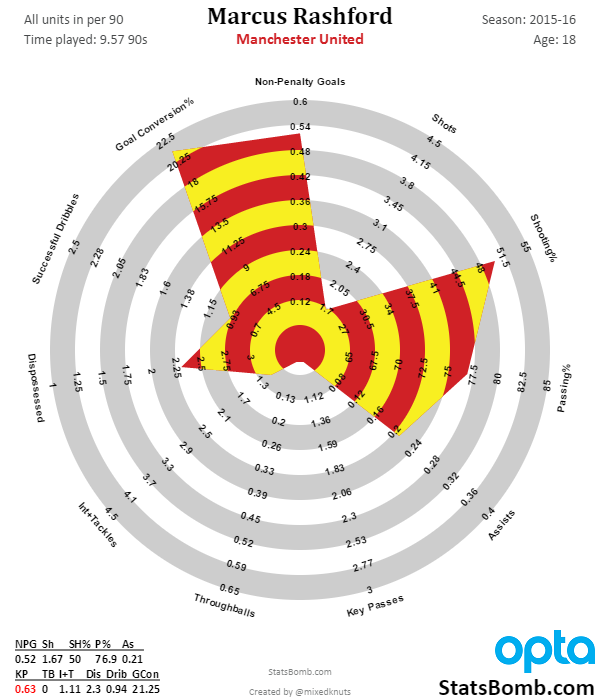
Compare this to what I produced from a similar small sample size of Harry Kane games and you can see what might be worrisome.
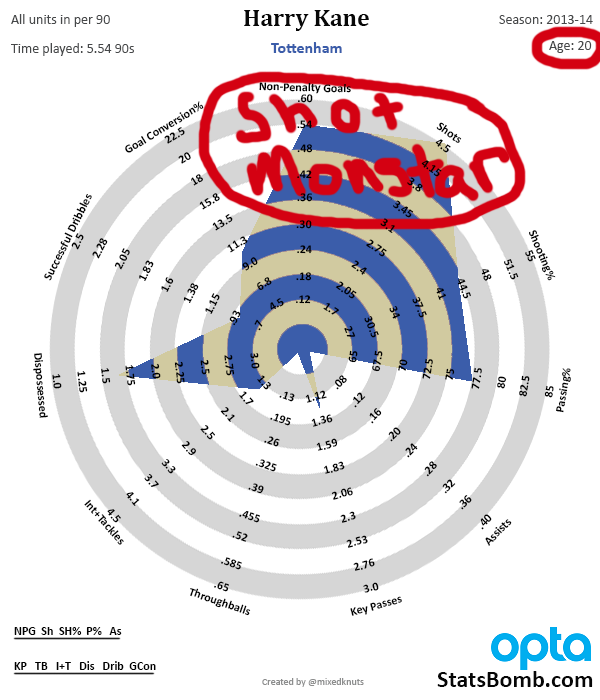
Then again, I was poking around with the radar generator and remembered that this looked very similar to another player whose goal scoring has consistently surprised me at Lazio.
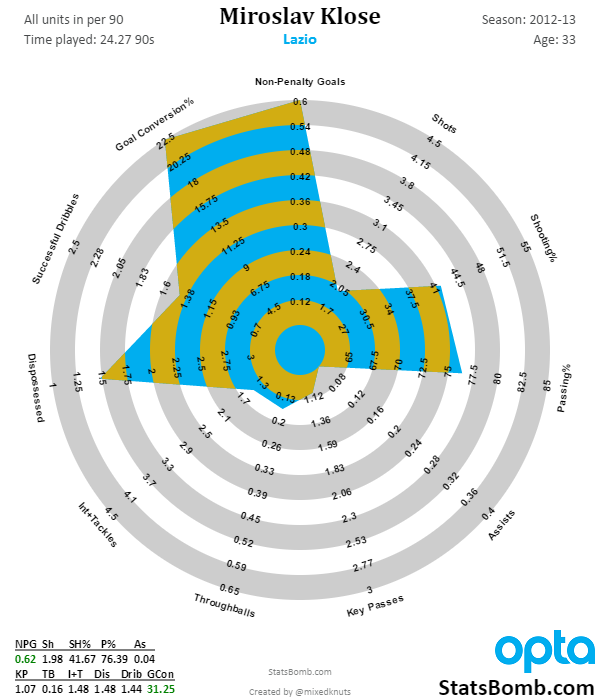
Klose has an amazing knack for scoring goals without generating a lot of shots, and it has been surprisingly sustainable in Serie A. Bas Dost is another guy who consistently generates amazing expected goals per shot throughout the data I have on his career. Maybe Rashford is a shot quality monster without being a volume monster?
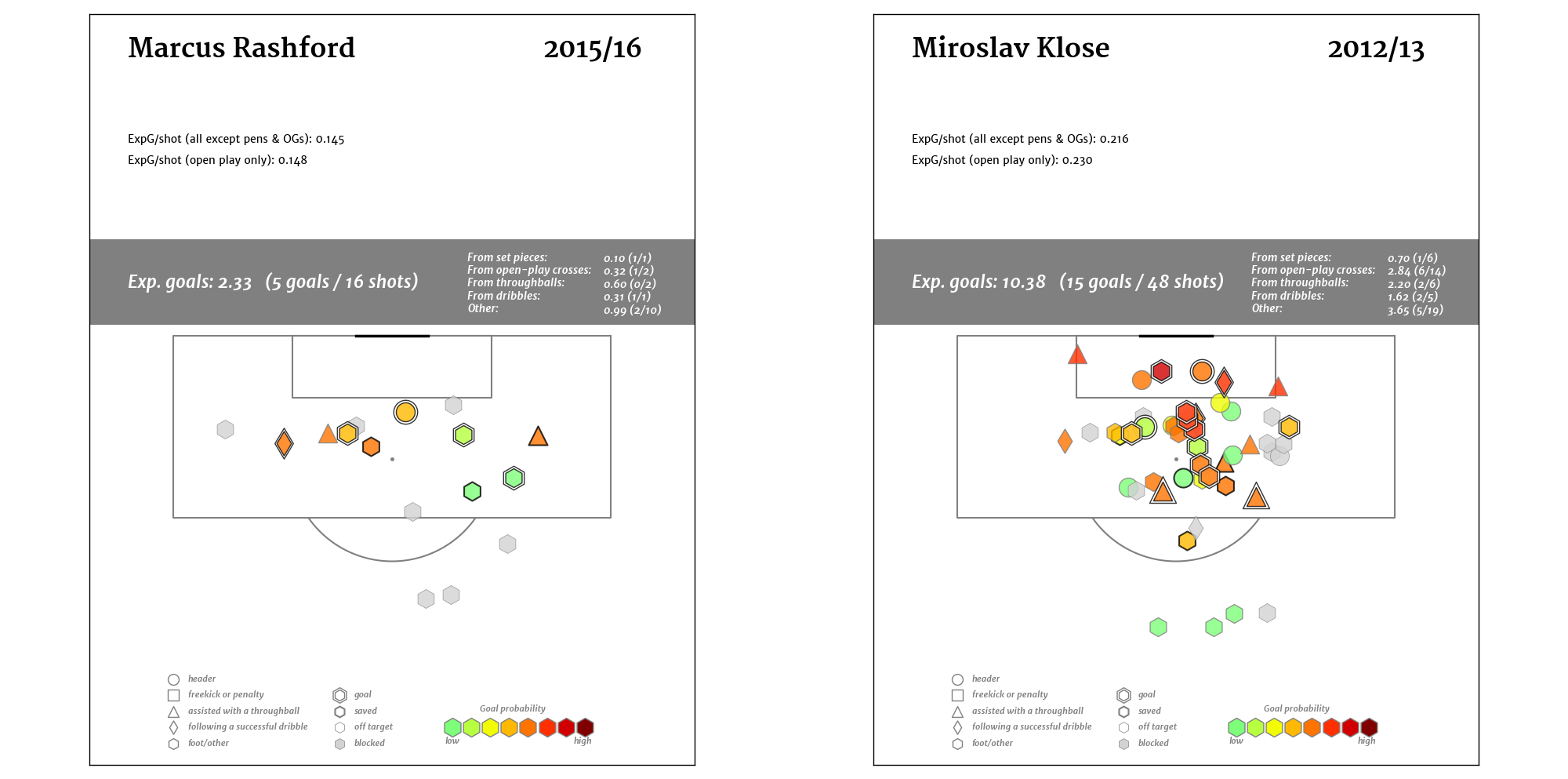
Or maybe not… Rashford’s shot quality is solid for a center forward, but nowhere close to the elite levels of Klose or Dost.
So yeah, he’s probably riding a bit of a hot streak, and maybe he was also fortunate to be chosen by Hodgson to go to Euros. I don’t have a problem with it – England always seem to take a teenage player to major tournaments anyway, and Rashford is this year’s mascot.
What Can We Infer About Rashford’s Future Career?
Short answer: not much, but he’s likely to be pretty good.
The reason behind this are the two elements I mentioned above.
It is damned hard for 18 year olds to perform against adults, and that’s especially true in the Premier League. Rashford has done that, so the null hypothesis – in my opinion at least – is that he’s pretty good simply by being selected at all and then scoring goals.
Okay, but what about the shot volume issue? Well that is the tricky element that forces us to look more closely at player development, and how we think it occurs versus how it actually occurs. For those of you unfamiliar with this topic, there’s a concept out there called the age curve and it suggests that on average, football players peak somewhere between 24 and 28.
Now this doesn’t mean that all players peak in this period – some might peak at 22 and others strangely late at 30 – but across the population this trend holds very strongly to be true. Marcus Rashford is 18, meaning he probably has another five to six seasons before we see his peak output. Add five or six years of shot volume to a trending chart and you’ll likely wind up somewhere pretty good.
On the other hand, don’t expect this to be a smooth curve – real player development tends to be anything but. This chart is taken from baseball velocity development (thanks @drivelinebases), but skills and output in football are similar.
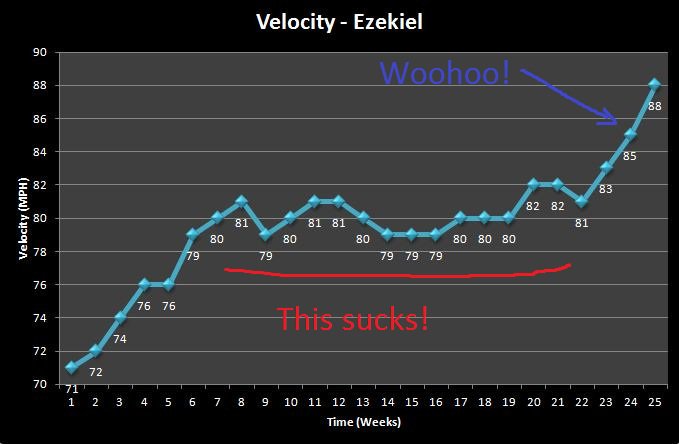
If you are expecting a smooth curve, you’d get to week 14 or 15 and want to kill yourself.
OH MY GOD WHY IS THIS NOT WORKING?!?
The human body, biomechanics, the sport of baseball (or football) are all incredibly complex things, so expecting an easy input to output relationship is a recipe for disappointment.
And calling the peak versus the plateau is almost impossible. Has Romelu Lukaku peaked yet? I don't know - he's looked like a grown ass man since he was 17 years old. I can give you a probability as to whether this has happened or not, but the fact of the matter is that I am not going to KNOW the answer to that question for another couple of years, and neither will anyone else.
This is why focusing on the process matters.
You can control the process, even if you rarely control the outcome.
This is true in player development just as it is true in the league table. Back to our young Manchester United player - with this small an amount of league data, we don’t know how Rashford will develop, so we have to make some guesses based on the aforementioned selection biases as priors. 18-year-olds who score reasonable amounts of goals in the Premier League tend to go on to have excellent Premier League careers.
That said, would I want to rely on Rashford to be United’s primary striker next season? Eh…
Can We Use Data to Evaluate Young Players?
This question came up at Science + Football a couple of times and the answer is yes, with some caveats.
- The first challenge is getting reliable data, and many years of it.
- The second challenge is making sure that data stays valid.
- And the third challenge is using that data to build trends where you can evaluate approximately how good those young players are and how good they potentially will be.
You are never going to be perfect with this. You might not even be able to get close. But you can probably get better than knowing nothing objective, which is an improvement on the status quo.
One thing I suggested to Midtjylland’s academy last year was that they get on the same data format that we use to evaluate first team prospects, so that we’re able to match up all the advanced metrics and provide them with similar analytical tools.
Additionally, with enough information, we could start evaluating statistical development patterns in their best youth players. In order to do this, they would need to send off past seasons of video to be coded by Opta (the data company we used) at the U-19 and potentially U-17 levels.
With this information, we could then track a player’s progress through the development teams and into the first team (or other clubs in the data set), and understand what those players looked like at different stages in their development.
Another area where tracking younger player statistical output is potentially a huge boon is with teams that have a lot of loanees. If a Manchester City or Chelsea send all their loanees to leagues where they have data, they will gain an incredible amount of clarity about their own players’ performance.
They can then use that information to better assess what the next loan should be, as well as which players are most likely to become good enough to make their first team, and which players are probably better to sell on now.
With the right people working on this project, they can also develop an objective pricing model for those players’ future transfer values. Given all the information above, perhaps the most interesting questions now are
- What should we expect from Marcus Rashford next season? and
- What would be best for the continued development of his career?
The new manager at United is Jose Mourinho, a genius, but also someone who has been remarkably stingy about handing out valuable playing time to young players. What likely will not be best for Rashford will be to ride United's bench for the entire season, with only a handful of Cup appearances to his name.
Mailbag – Updated Thoughts on Alvaro Morata, Scouting, Manager Evaluation and More
Mailbag time! Readers ask questions. I promise to answer the best of them and not make fun of the worst of them.
I also promise to answer all of these questions honestly to the best of my ability, and not to lie or misdirect people from the truth.
Mostly.

Depending on what sort of tools the people you hire bring with them, maybe a month? To some extent it depends on how quickly you get the data company to send you the data, and how much time it takes you to get it organized. As long as I can query a database, we can get work done.
If I walked into a new club tomorrow that worked with Opta data, it would be a matter of days before I could advise on recruitment and maybe a month or two before the Death Star becomes fully operational. On the other hand, any analytics department should spend at least a fraction of their time learning new things so that the value of their output always increases. The curve of starting from scratch is somewhat painful, but as long as you can be less wrong than the teams you are competing against, you have an edge.
Statistical analysis in sport is a competitive endeavour and you will never, ever be smart enough.
Cost is a hella-tricky one right now, and I can tell you this out of personal experience. Part of this is because all of this is new, and football is still confused about the value of the role.
- A performance analyst role is probably £20-30k on average.
- Data analysts are not the same as performance analysts.
- A top data scientist is well into six figures as a base salary in the corporate world. Add some experience to that and you get serious money. (Well, serious for normal people, not for footballers.)
- Good data people in football should be able to save you millions of pounds a year in the transfer market
- Smart data people in football should also be able to generate goals on the pitch, provided they are listened to and integrated as part of your process.
- A single Premier League goal probably equates to £2M next season.
Now consider the fact that in American sports, estimated average salary for General Managers is $2M, depending on sport. (General Manager = Director of Football or "People who can use data to make smarter decisions")
And there’s a pretty strong argument that the good GMs are vastly underpaid. (Read this from Benjamin Morris to explain why.)
Tricky, eh?
If you are willing to hire smart kids right out of school and deal with the mistakes and learning curve alluded to above, you can probably staff a full department for £150k plus data costs. If you want more experience - and there just plain aren’t many people who have experience in stats and have worked in football right now - multiply that by a lot, but you should still get huge value.

For those who are unaware, Kevin de Bruyne is one of my favorite players in the world and has been since his first Bundesliga stint at Werder Bremen back in 12-13. When I first started writing about statistical transfers in summer 2013, I suggested him as a cheeky option as a wide attacker for Arsenal, and then thought Chelsea sold him to Wolfsburg for 50% less than they should have. Also two of my three kids are gingers, so “Ginger Freak” is a very affectionate nickname.
Obviously I am still totally in love with the Ginger Freak. He’s one of the best players in the world in transition and this season you can see him learning to become a better player in and around the box. Thinking about what he could become under Pep’s tutelage is the kind of thing that will make City games only air after the watershed next year.
Sorry kids, mature audiences only.

Britain has a fairly huge “manager” problem right now. Tactically, the country was backwards for a very long time, especially in the lower leagues. The style of football many of the current 40-60 year old coaches learned is not a great style for the modern game. Thus you are seeing more and more coaches from other countries imported into the Premier League and Championship.
Are they smarter? I don’t know, but for whatever reason, they certainly seem to have had a better football education.
I have a lot of ideas about how to find and educate better coaches – so many that I can’t fit a reasonable answer here. I have also been interacting with smart young coaches a lot in the last year, and I think the next generation of coaches here in the UK will be much more modern and forward-thinking.
If I were a young coach in England right now, I would aggressively try to find internships under coaches that are tactically innovative, because that will give you and edge in the future and the country needs that. You need to learn what they have to teach you, and you need to see how they train those tactics in sessions on the pitch.
If I couldn’t find helpful internships in England, then I would go to Germany or Spain to learn instead.
Coaching is a knowledge-based occupation. If you were going to university, you would seek out the best possible place to teach you. You need to do that with football too, it’s just that instead of a centuries-old university system, you get the chaos and disorder of modern football.
Good luck!

Rico Henry from Walsall.
English. 18 years old.
League One team of the season.
Left footed.
Plays Left Back.
Zoom zoom.

For those who have never heard of it, Smartodds is my former employer, and is owned by the same person who owns Brentford and Midtjylland football clubs. The team I was part of sat inside the company, but worked primarily for the clubs – a bit like City Football Group does for Manchester City and their sister clubs in New York, Melbourne, and Japan.
The first project I worked on for Smartodds was probably the most valuable thing I will ever create in football, and I never would have worked on that unless Matthew Benham asked me to do so. It also made me realize how much space exists in football for smart people to innovate.
If you are a team and you want to know what that project was, you can hire me to explain the details. My contact info is at the bottom.
Beyond that, it was fascinating to learn just how hard it is to get transfer deals across the line. Even when you find players early and are the first club to show an interest in a player, and everything looks great the entire time, so many transfers just do not work out.
The other big lesson is that even when you exist in a place surrounded by smart people, plenty of mistakes will be made. It’s part of life, it’s part of science, and it’s part of football.
Learn the lessons and do better next time. It’s so fucking vanilla and self-help it’s almost painful to type, but it’s the truth so there you go.

In terms of recruitment, analytics creates a bigger multiplier in lower leagues but in real monetary value, just avoiding mistakes in the top leagues is strictly worth more.
To explain: The majority of individual transfers in the top half of the Premier League this season will cost more than what Brentford paid for their entire squad. A team can buy a lot of guys for £500k and sell them on later for £2.5M. You can’t buy a lot of guys for £10M and flip them for £50M though – there just aren’t enough £50M buyers out there (or likely £50M talents).
My team at Smartodds was probably one of the few in the world that did extensive work on transfer evaluations from small and medium leagues throughout the world. Most of the teams that have analysts working on recruitment are in the Champions League and don’t need to look that far down the ladder to find talent. Because we had one of the smallest budgets in the league, we did and we learned a lot because of it.
Number of Championship clubs that have talked to me so far this year about recruitment or anything else: 1.
Seems like plenty of teams are missing some tricks right now.
With regard to everything else stats dorks can do in opposition scouting, style of play, etc, the value is probably equal across leagues, but the competition is worse at the lower levels, so it should be easier to win disproportionately more there on a small budget.

Tell me what you see on the pitch. What’s the first touch like? How does the player evaluate game situations? What mistakes are being made? What took your breath away, even if it didn’t quite work out? We have a scouting template that highlights the important stuff we want to know, so evaluate that.
Don’t worry about what the stats might have missed. If you explain the football you are seeing in front of you, that stuff should come out anyway.

I thought Morata had an excellent season last year. Adjusting to a new league can be tough, and his performance was still exceptional for a young forward.
On the surface, this season has not gone quite as well, but I’m not sure I agree. Scoring contribution per90 in the league this season was .80. Last year was .88. There no noticeable difference in output except last season he had more goals and this year he had more assists.
He also had 2 goals and 2 assists in 534 Champions League minutes against tough teams, including this piece of filth at Manchester City.
And yet worries (and the narrative) persist. The question you start to ask is why might this season be different than all the others? Stats won’t really tell you the answer to that, so I’d watch every match and compare it to previous years. What’s going on behind the scenes as well? For the numbers being batted around now, teams need to do all their due diligence, almost regardless of whether they think this year was better or worse than Morata’s past.
I thought he was huge value back when he moved to Juventus in 2014. He’ll probably move for silly money this summer and the value will be gone. That said, if I was looking for a guy to lead my line, score goals, and create goals for his teammates as a center forward for the next four years, he’d still probably be it.
For what it’s worth, I still believe Memphis has a reasonable chance to be great as well, but I’m not certain that’s possible under LVG. Football is complicated. So are humans. Memphis only turned 22 in February. Stick him with a head coach that actually wants his forwards to attack and we’ll have a better idea of whether my evaluation was terrible.

There are a myriad of ways to profile head coaches/managers with data and find more objective ways to evaluate them than just the performance on the pitch. It’s actually one of the more valuable services an analytics team can provide to clubs, and there are consultancies out there that quietly do this too.
The big thing to take away from it is whether a particular coach fits the style of play your club wants to play and/or how your personnel might fit into their new style of play. If you have to bin half your squad simply by hiring a new head coach, maybe you want to look a bit closer at some other coaches whose style doesn’t require quite so much immediate, expensive change.
No one writes about it though, because it can be a bit boring and readers seem to care not at fucking all.
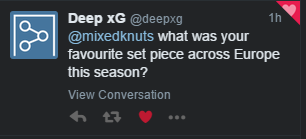
*awkward silence*
*clears throat*
Set pieces and their results are random. You might as well ask me about my favorite drop of rain.
*walks out of press conference*
*stops*
Fine, one last question.
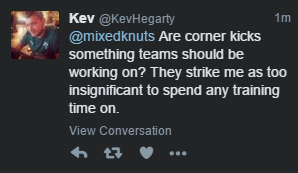
Eggggzactly. And on that note, I am out of here...
--Ted Knutson @mixedknuts mixedknuts@gmail.com
POSTSCRIPT

Manchester United: The Fallen Keep Falling
No one quite knows what is going to happen at the world’s biggest club this summer. What was supposed to be a season where United returned to glory looks a lot more like a dumpster fire of missed opportunity.
With performance at the top of the league as weak as it has ever been, it’s shocking to find United once again likely to miss out on Champions League play. The question is why? Is it van Gaal’s fault? Are the players not good enough? Is there a brain cloud over Manchester affecting the entire city’s footballing performance? Let’s find out!
Facts
- Transfermarkt estimates United have a net spend on transfers of £150M the last two seasons. I suspect this underestimates the Martial deal and includes flipping Angel di Maria to PSG for a loss, but it's a big number however you slice it.
- Combine that with nearly £60M spent the year after Sir Alex retired and you are looking at well over £200M invested into the playing squad the last three years, two of which were clearly guided by Louis van Gaal's requirements.
- United’s payroll is monstrous, though so too are their commercial revenues. They can get away with paying high wages, even to declining performers like Wayne Rooney.
In terms of quality, the recruitment has actually been pretty good. Shaw’s injury was bad luck, but Blind, Herrera, Shaw, di Maria, Martial, Memphis, and Schneiderlin are all excellent players. Schweinsteiger was always going to be an occasional guest star because his body was breaking down well before he left Germany, but he’s a classic “winning mentality” guy and a genuine leader.
So yeah, I don’t hate the recruitment aside from the prices paid, but if any team in the world can afford to spend to much on good transfers, it’s Manchester United.
And yet… this is actually difficult to believe but...
Manchester United are generating 11.3 shots a game.
That’s bad.
Actually, it’s putrid.
The only teams who create fewer chances a game are the three teams that are probably getting relegated plus attacking powerhouses West Brom Albion and Stoke.
Let me put this a different way…
BIG SAM’S TEAM TAKES MORE SHOTS A GAME THAN MANCHESTER UNITED.
Over £200M in net spend, can’t create more shots than Sunderland.
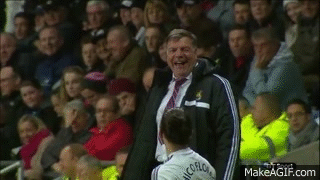
We can talk about shot quality all you want, but LVG’s United are taking 50% fewer shots than the elite teams in the league. That might be a problem if you want to compete for CL spots, let alone win a title.
Yes, the defense has been good, but there's a bit of luck involved. Okay fine, some say "luck", others say "the otherworldly skills of David de Gea." Either way, the tradeoffs for keeping the defense sound is making eunuchs out of all the attackers. That’s a huge systemic flaw, and the blame for it can’t be pointed anywhere else except van Gaal.
To illustrate the drop-off a little more clearly, I’ve taken shot maps from the last Fergie season and put them next to what United have done in 37 league matches this year for comparison.
Let’s start with the defense.
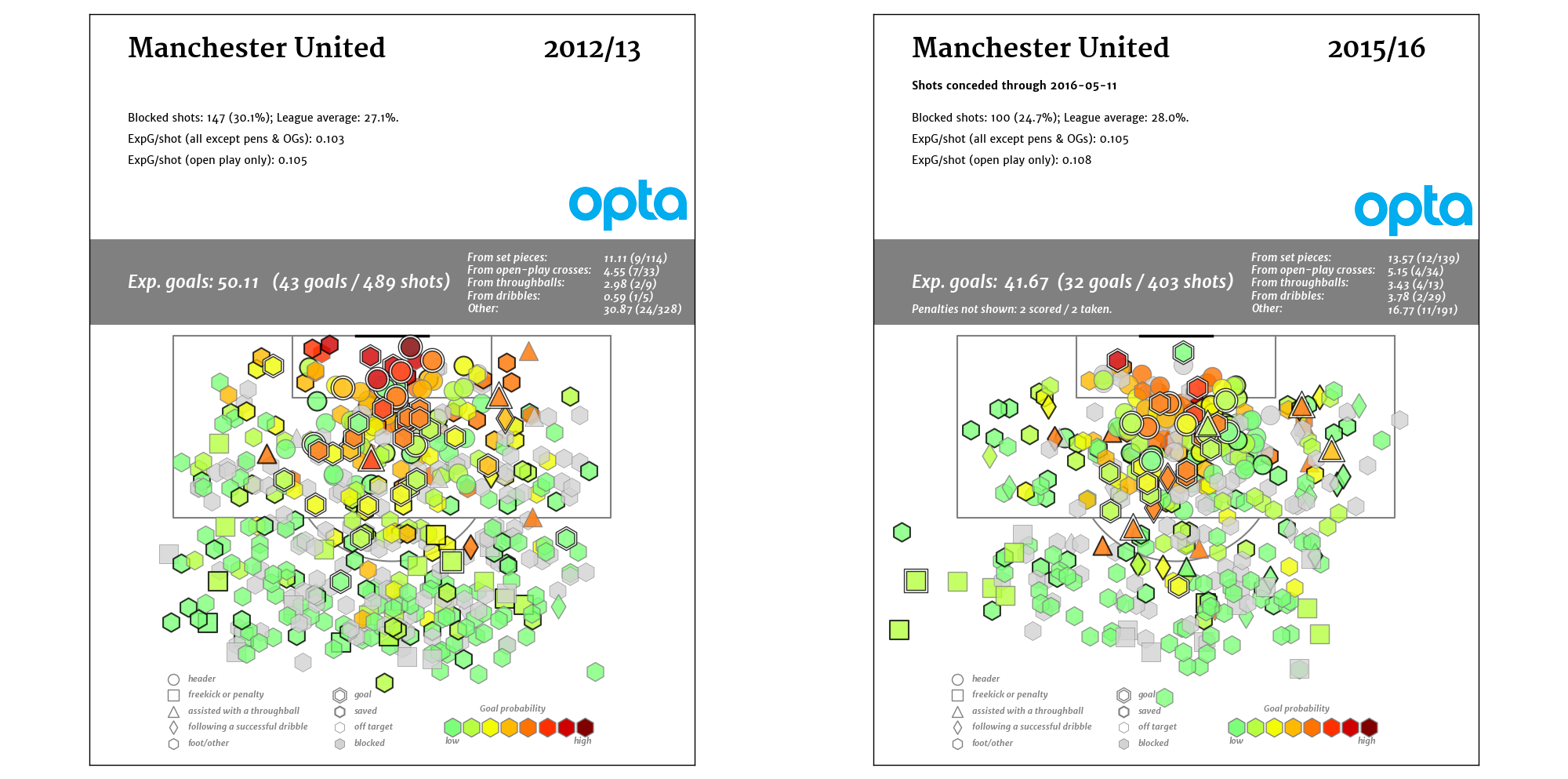
(Click to embiggen)
Despite giving up 20 shots to West Ham on Tuesday, LVG’s team this year will concede somewhere between 15 and 20% fewer shots than the last Fergie team. The quality of shot conceded is a fraction higher, while they block 5% fewer. So Fergie’s United gave up more volume in defense but the rest is a bit of a wash.
Now for the attack…
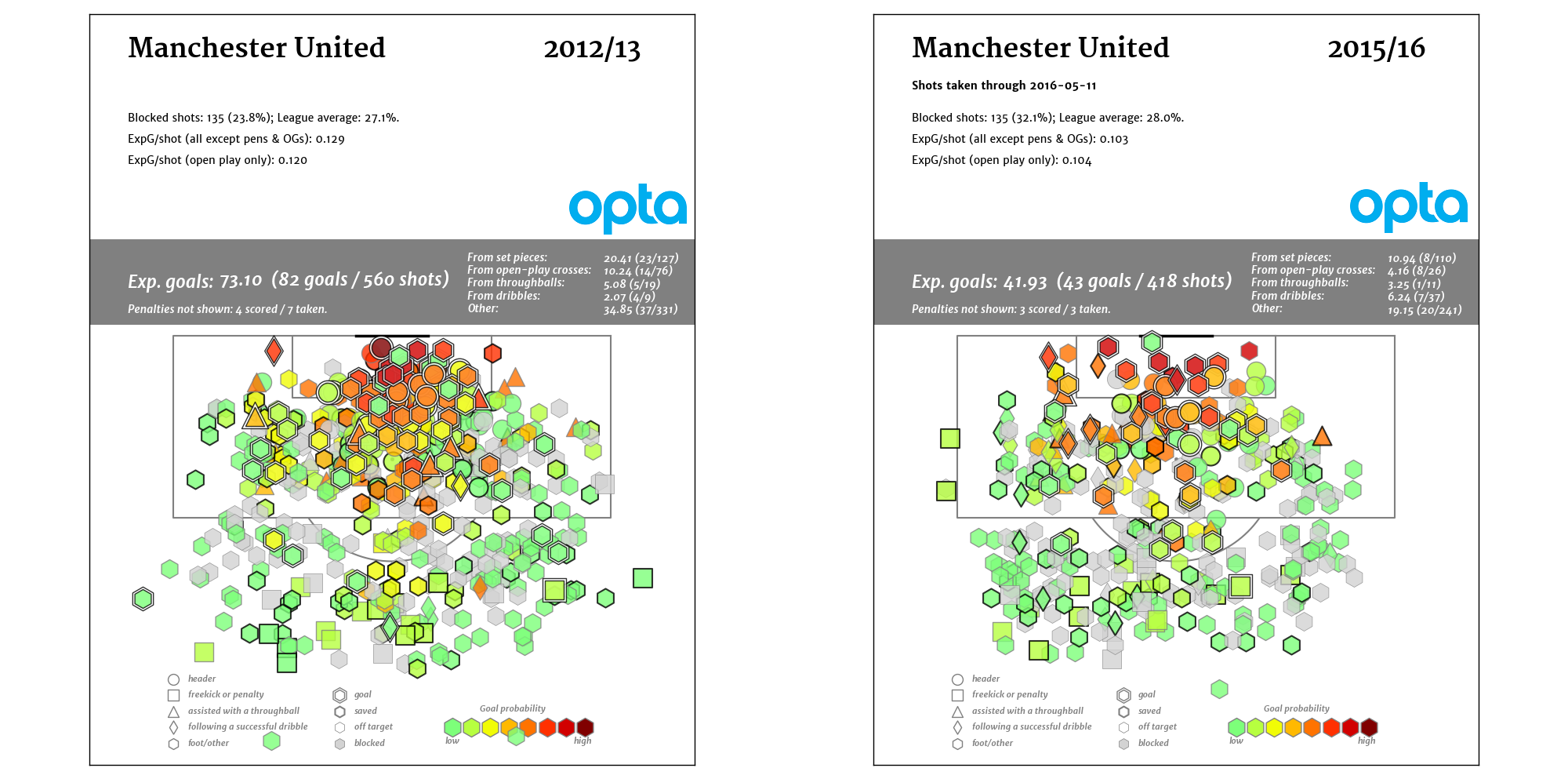
Woof.
25% fewer shots taken, which over the course of a season is 125-150 shots less. Quality of shot generated is also about 25% lower. Combine those two factors and you end up with a FORTY goal difference between the two years with one game left to play.
Fergie’s teams were amazing at generating central shots between the penalty spot on the goal. LVG’s are anything but, and that’s likely to cost them another Champions League campaign.
The players are good. Compare the squad to West Ham and Southampton, both of whom have scored more goals than United and have a better goal differential, and figure out which one you’d rather have.
United are losing out compared to title contenders in attack, and their players aren’t allowed to attack aggressively because how they defend doesn’t allow it. So to me, the problem is the tactical system they are playing, which is dictated by...
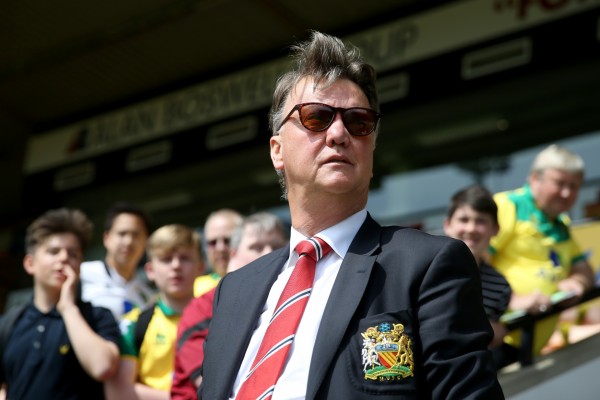
Non-United fans love van Gaal at least as much as David Moyes, which pretty much tells you everything you need to know about how good United have been under the former Dutch master.
